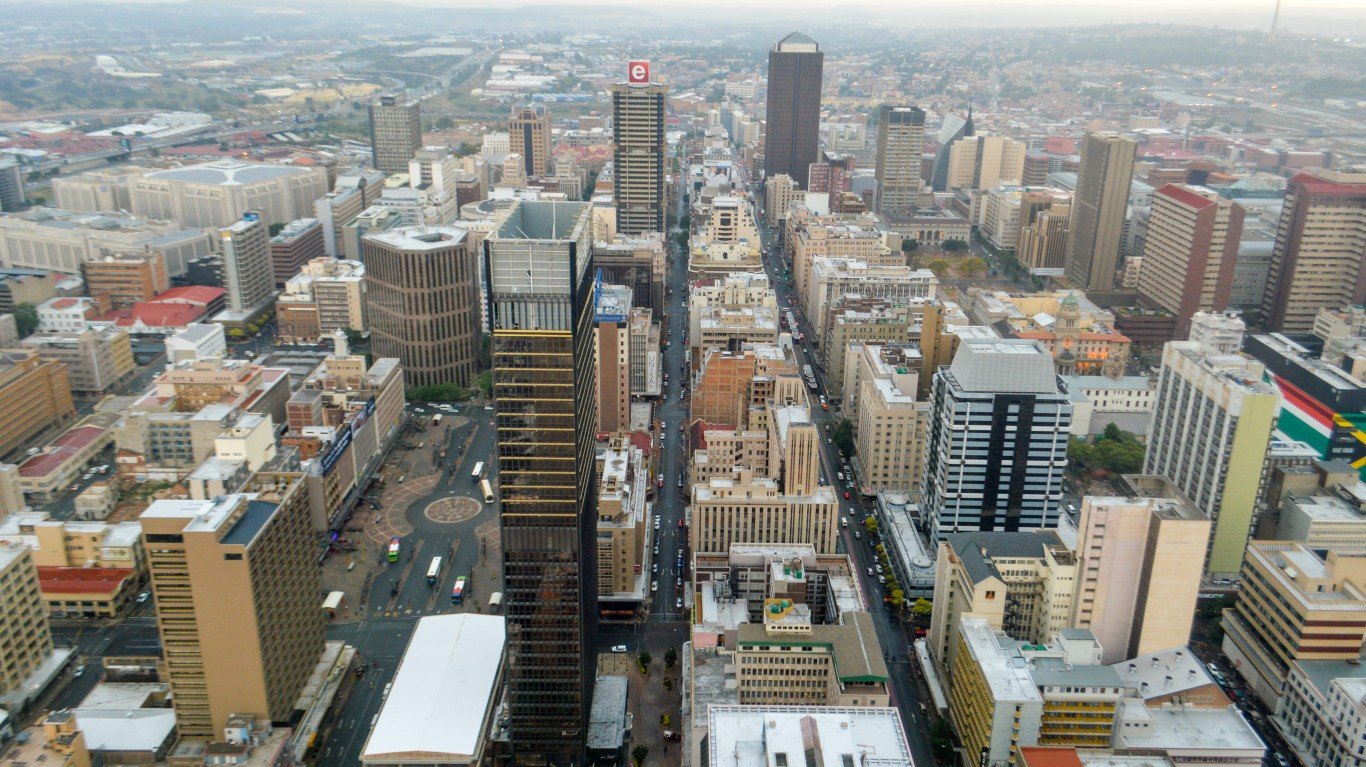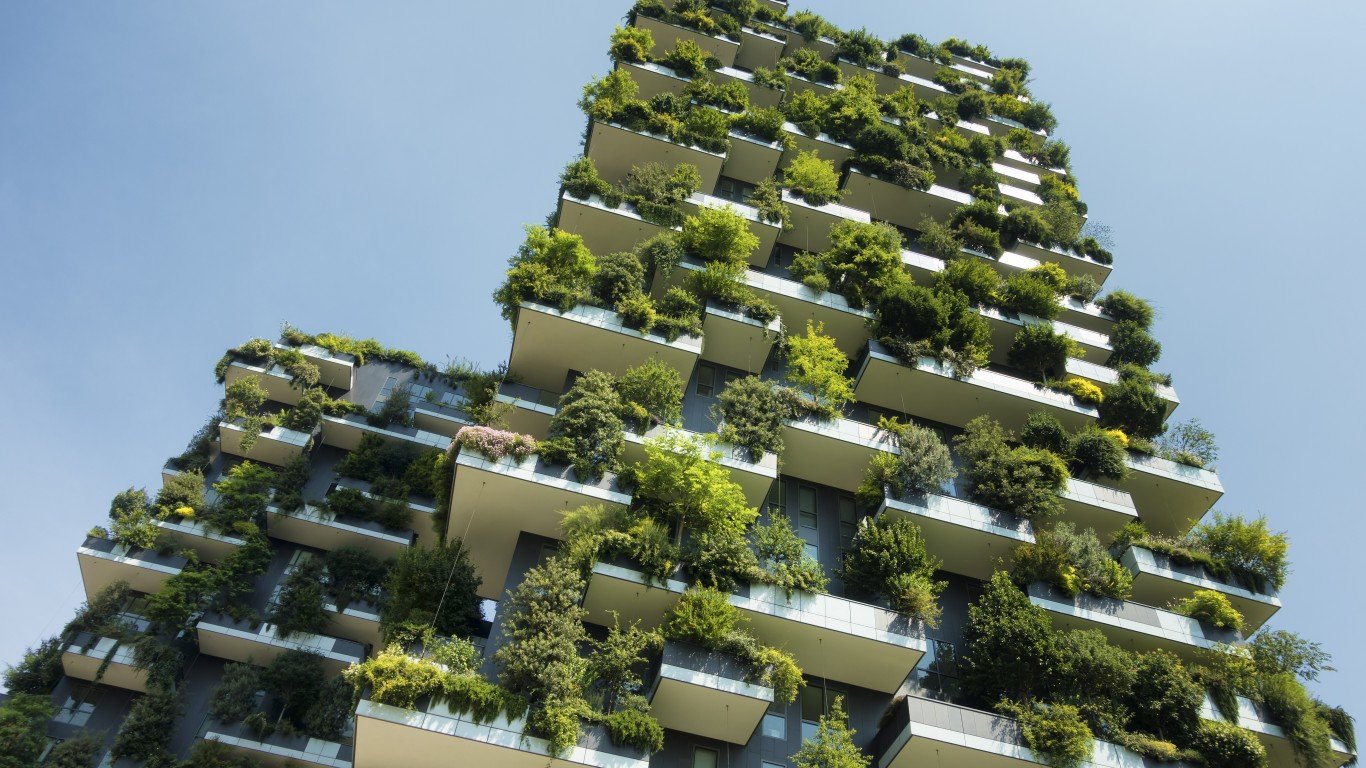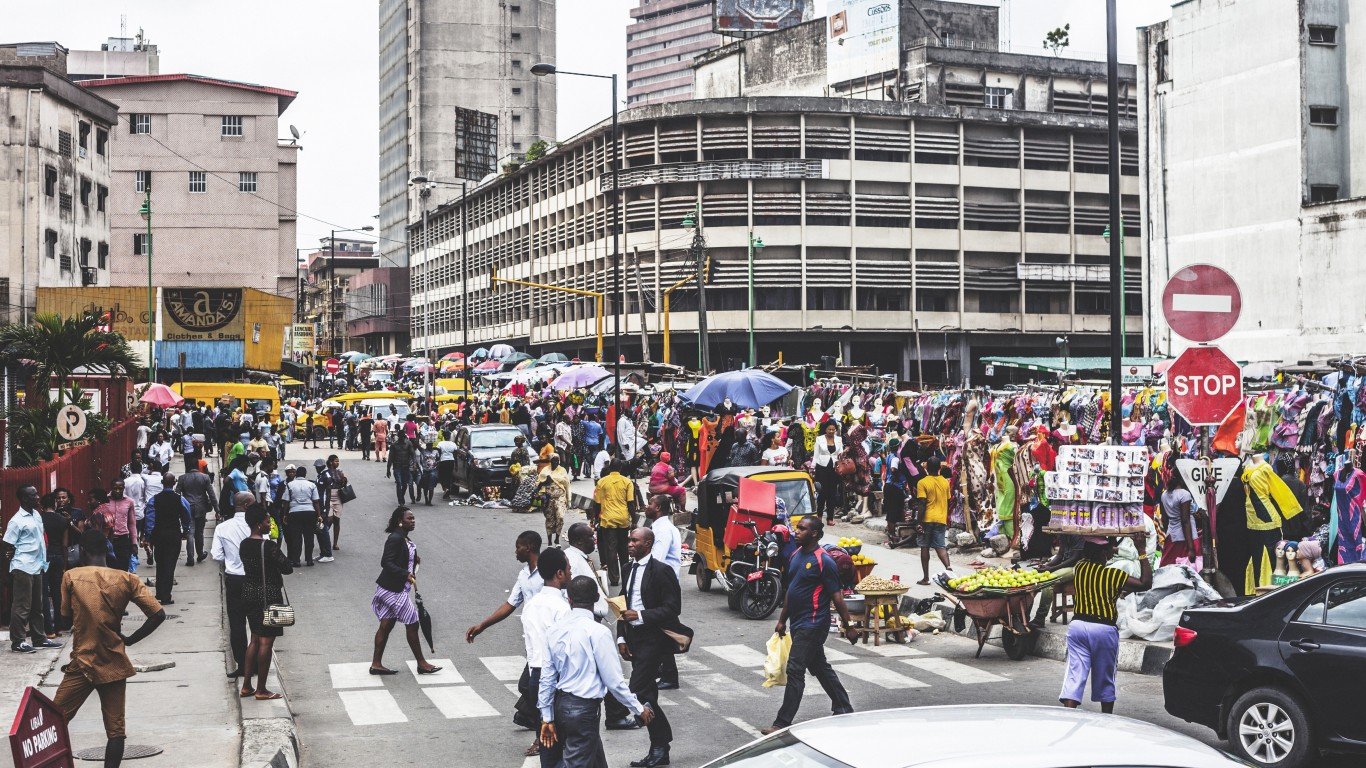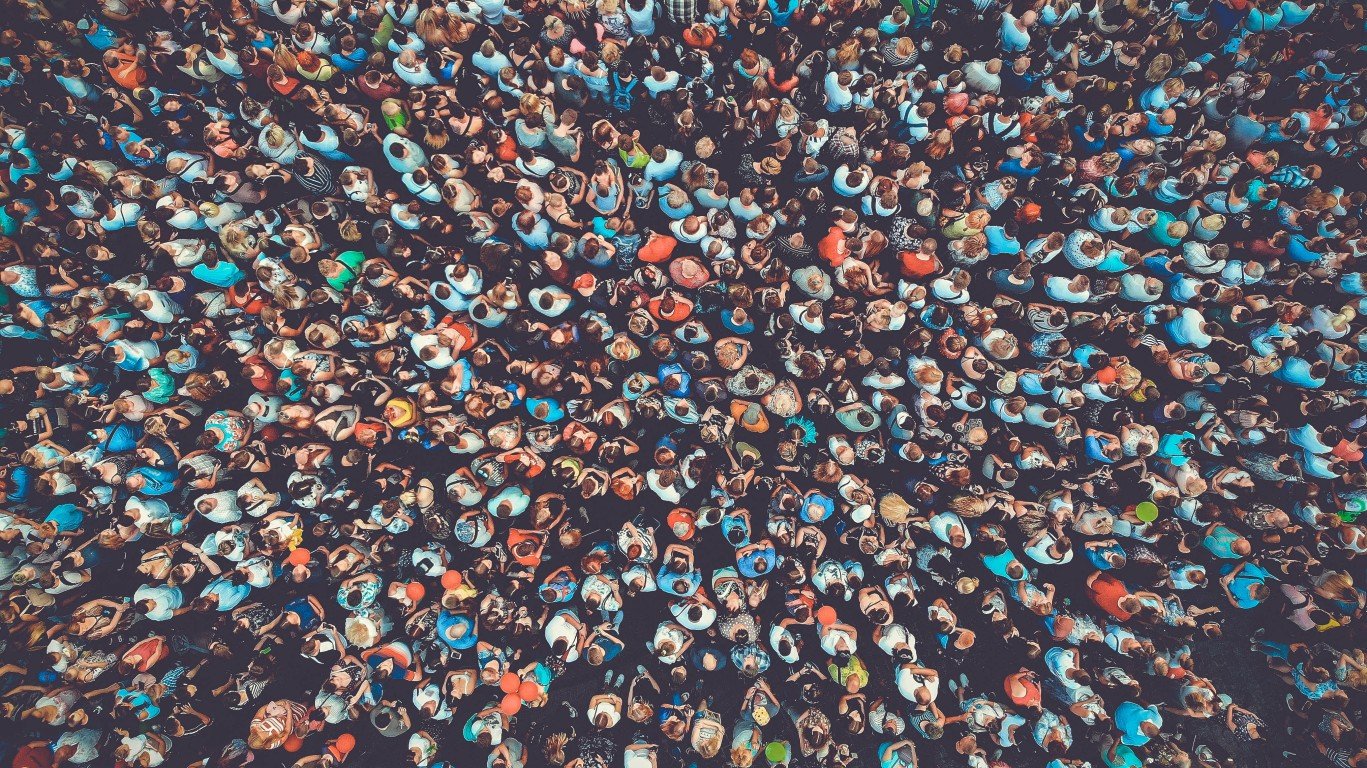

Megacities — defined as having 10 million residents — can be found worldwide. But who exactly is considered a city resident? The answer to this question is actually not that clear cut because there are inconsistencies as to what constitutes a city. Moreover, there are also different definitions for metropolitan or urban areas boundaries. Well, using urban development research group Demographia’s classification of urban areas, there are 44 such cities in the world today.
Demographia, rather than using any official boundaries of cities or jurisdictions, uses built-up urban areas definitions, explaining that such urban areas “function as an integrated economic unit, linked together by commuting flows, social and economic interactions.”
To identify the world’s 44 megacities, 24/7 Wall St. used data from the August 2023 edition of the World Urban Areas report from Demographia. Cities on the list are ranked based on their population. All data is from the report except for gross domestic product, which came from CEOWorldBiz. The matter of boundaries is particularly important to calculating GDP, and while some lists may rank New York as the largest economy among world cities, this list ranks Tokyo as the largest.
By far, Asia has the largest number of megacities, with 26 in the East Asia and Pacific region, including 11 in China. Of the eight cities in the South Asian region, five are in India. There are also four cities in sub-Saharan Africa, as well as four in Europe and Central Asia, including Paris and London. Six megacities are in Latin America, and two — New York and Los Angeles — are in North America. (Also see: The Wealthiest Cities in Every US State.)
Many of these cities have a diverse cultural mixture as well as governing challenges that include infrastructure, population density, and environmental problems.
44. Tianjin, TJ, China
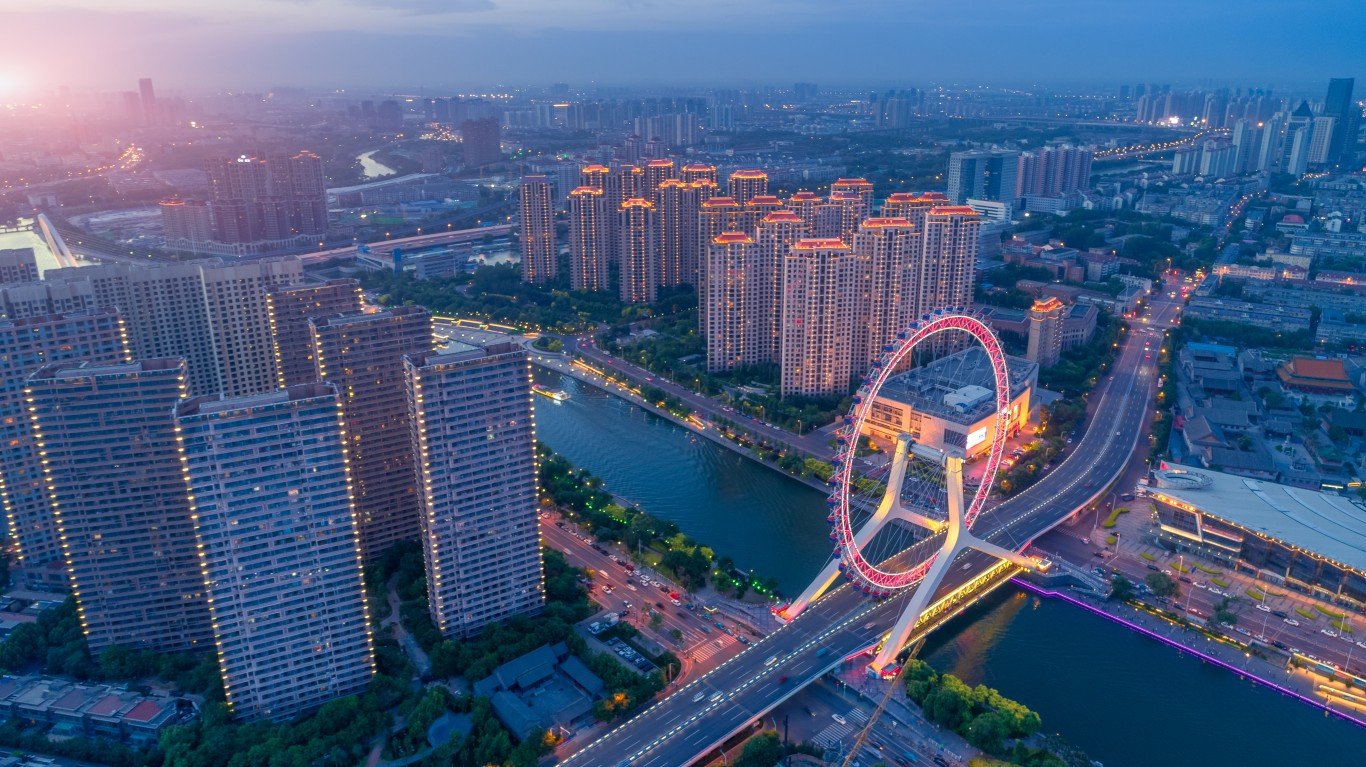
- Estimated population, 2023: 10,047,000
- Built up urban area, 2023: 1,086 square miles (or 2,813 square km) — #33 largest of 986 urban areas
- Population density: 9,251 people per square mile — #655 densest of 986 urban areas
- Est. GDP, 2023: $235.66 billion — #51 largest metro economy
- World Bank geographical region: East Asia and Pacific
- Country class (World Bank): Upper middle income
43. Bogota, Colombia
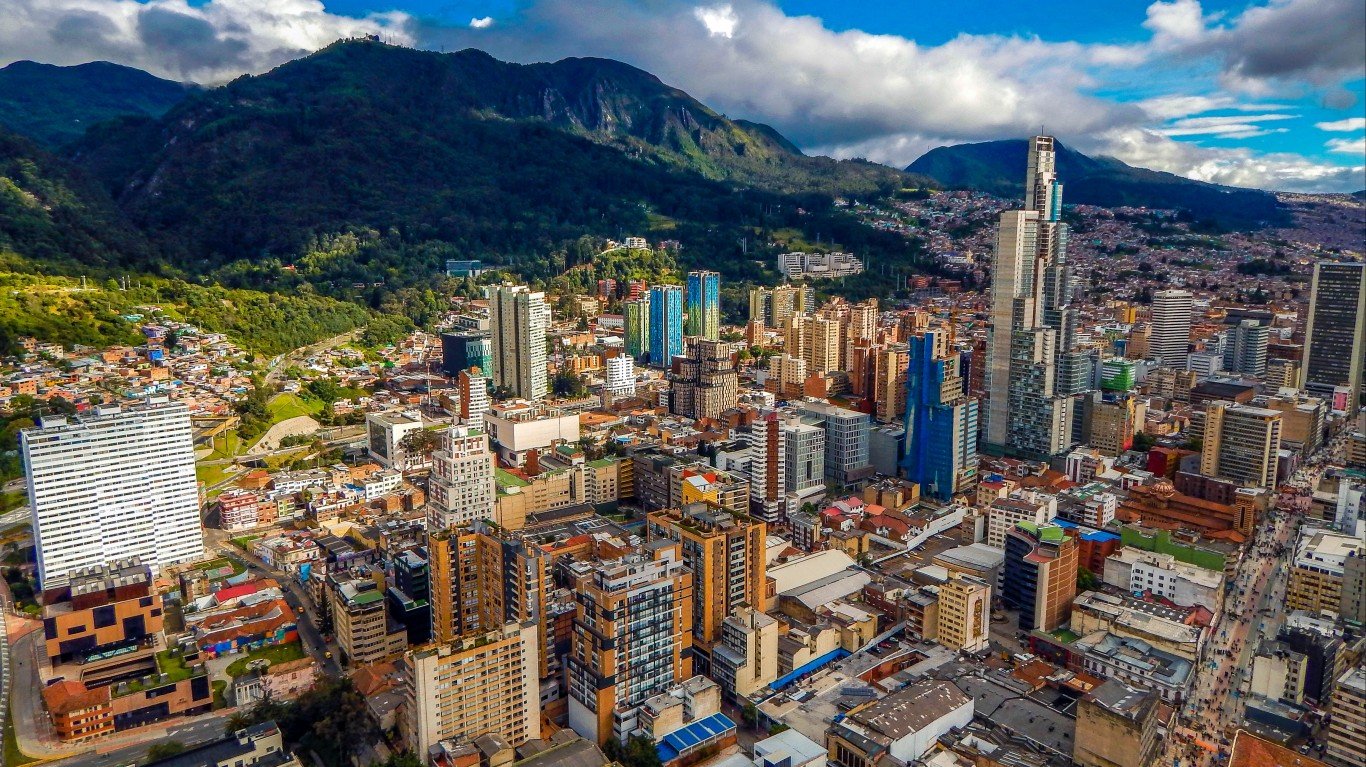
- Estimated population, 2023: 10,252,000
- Built up urban area, 2023: 217 square miles (or 562 square km) — #241 largest of 986 urban areas
- Population density: 47,244 people per square mile — #36 densest of 986 urban areas
- Est. GDP, 2023: $159.00 billion — #92 largest metro economy
- World Bank geographical region: Latin America and Caribbean
- Country class (World Bank): Upper middle income
42. Wuhan, HUB, China
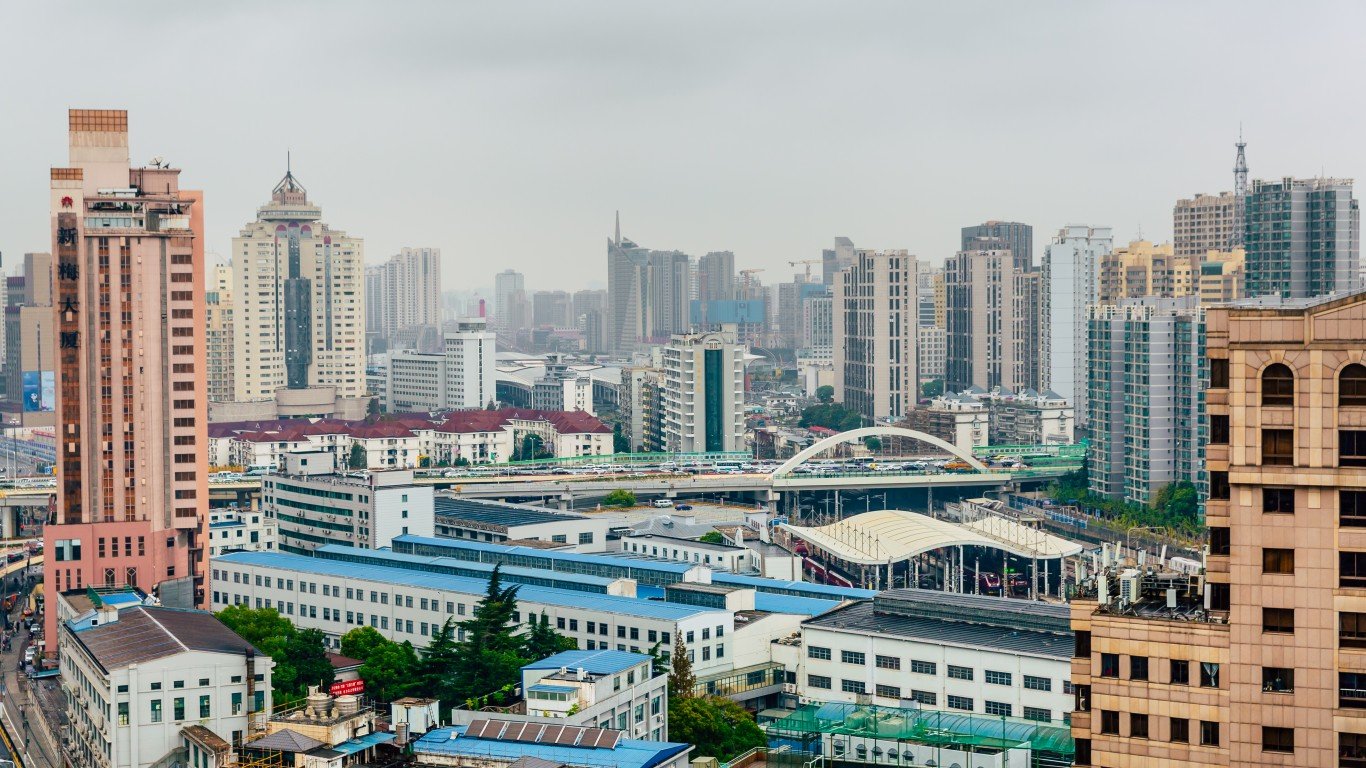
- Estimated population, 2023: 10,353,000
- Built up urban area, 2023: 703 square miles (or 1,821 square km) — #60 largest of 986 urban areas
- Population density: 14,727 people per square mile — #388 densest of 986 urban areas
- Est. GDP, 2023: $274.68 billion — #38 largest metro economy
- World Bank geographical region: East Asia and Pacific
- Country class (World Bank): Upper middle income
41. Lima, Peru
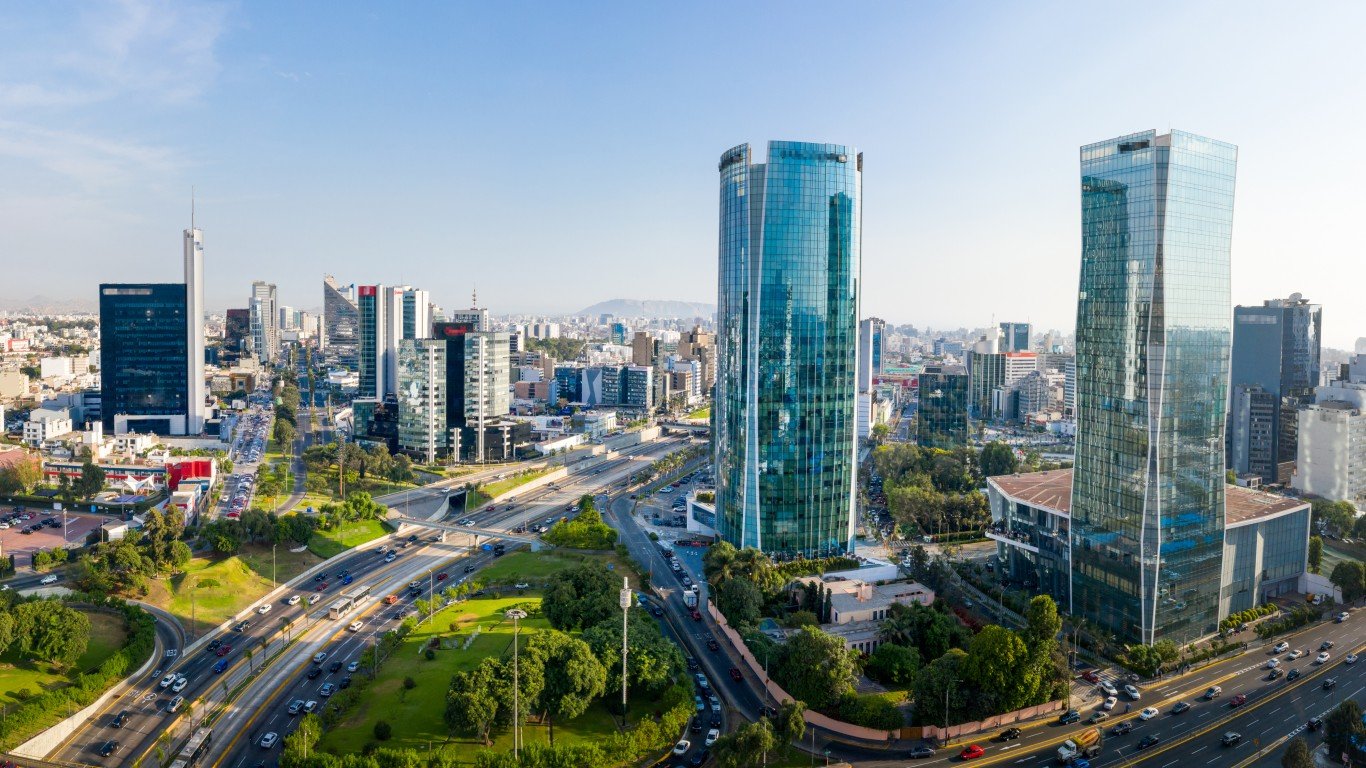
- Estimated population, 2023: 10,556,000
- Built up urban area, 2023: 344 square miles (or 891 square km) — #152 largest of 986 urban areas
- Population density: 30,686 people per square mile — #114 densest of 986 urban areas
- Est. GDP, 2023: N/A
- World Bank geographical region: Latin America and Caribbean
- Country class (World Bank): Upper middle income
40. Dongguan, GD, China
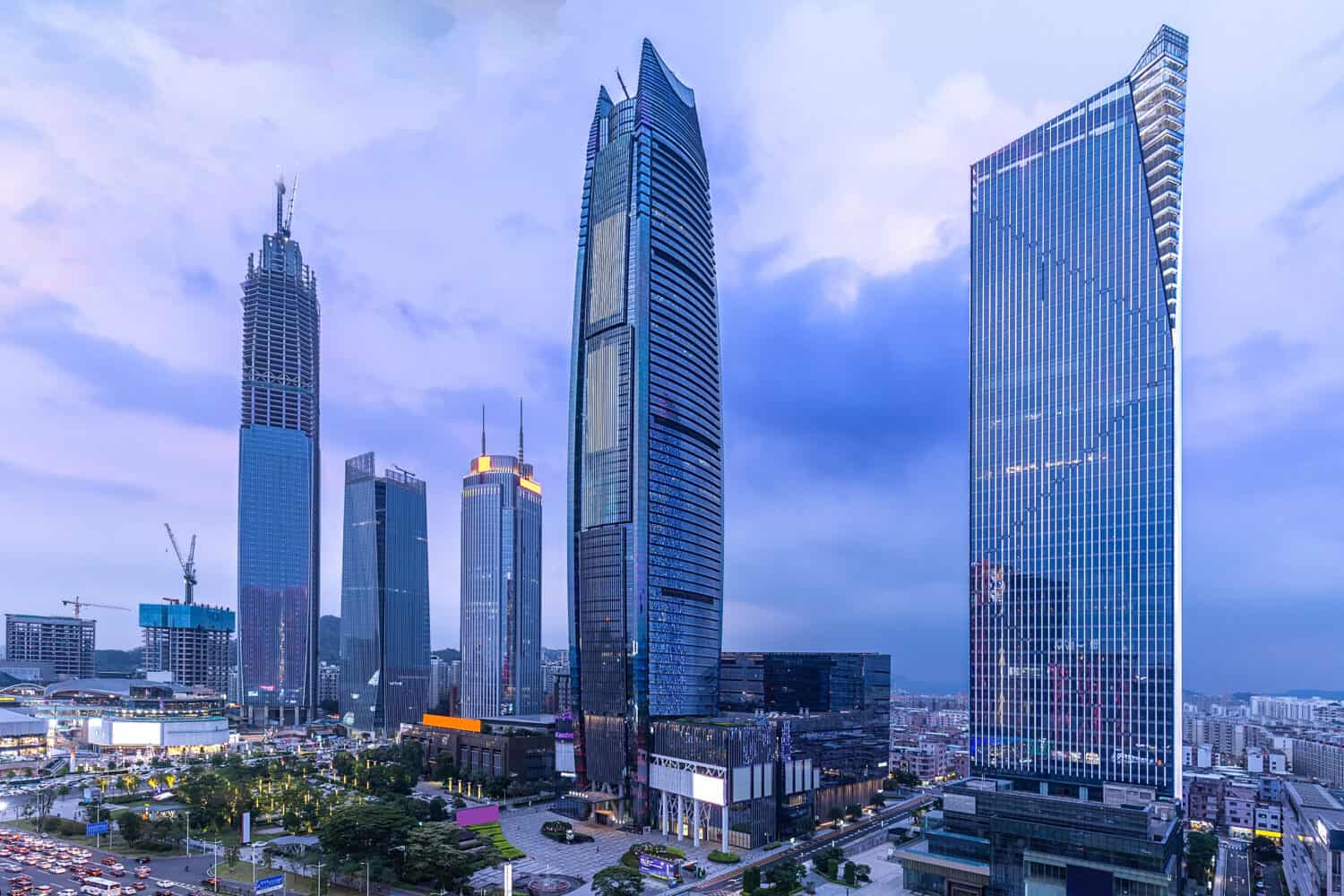
- Estimated population, 2023: 10,753,000
- Built up urban area, 2023: 679 square miles (or 1,759 square km) — #63 largest of 986 urban areas
- Population density: 15,837 people per square mile — #346 densest of 986 urban areas
- Est. GDP, 2023: $112.30 billion — #114 largest metro economy
- World Bank geographical region: East Asia and Pacific
- Country class (World Bank): Upper middle income
39. London, United Kingdom
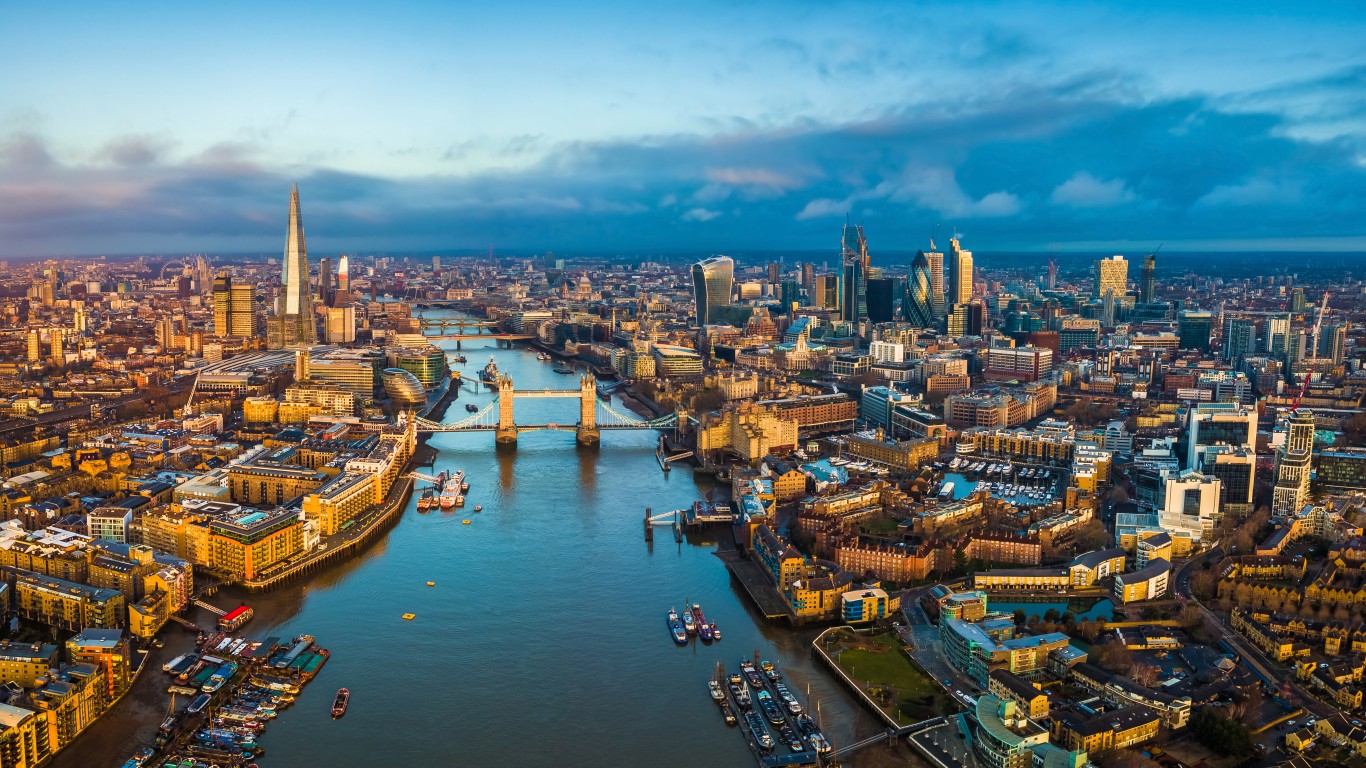
- Estimated population, 2023: 10,803,000
- Built up urban area, 2023: 671 square miles (or 1,738 square km) — #68 largest of 986 urban areas
- Population density: 16,100 people per square mile — #333 densest of 986 urban areas
- Est. GDP, 2023: $978.40 billion — #4 largest metro economy
- World Bank geographical region: Europe and Central Asia
- Country class (World Bank): High income
38. Luanda, Angola
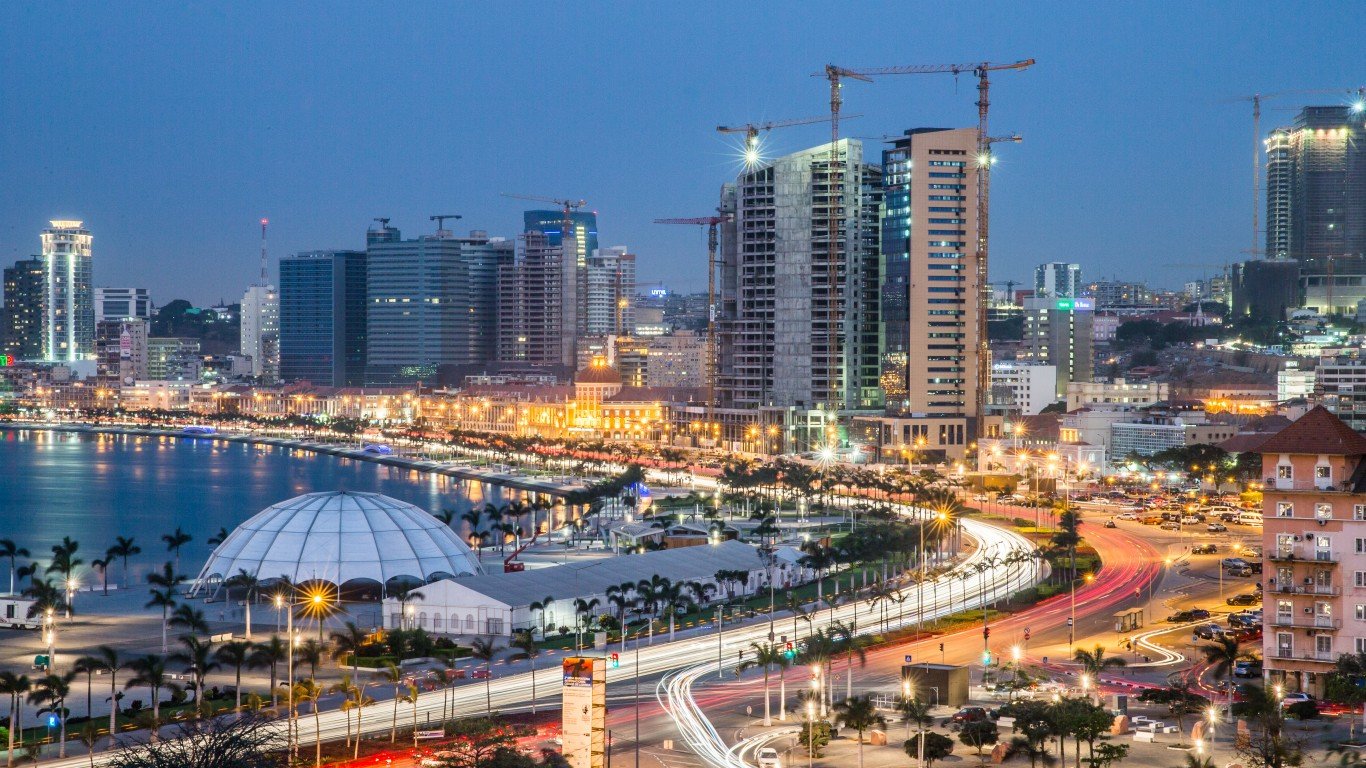
- Estimated population, 2023: 10,914,000
- Built up urban area, 2023: 388 square miles (or 1,005 square km) — #126 largest of 986 urban areas
- Population density: 28,129 people per square mile — #133 densest of 986 urban areas
- Est. GDP, 2023: N/A
- World Bank geographical region: Sub-Saharan Africa
- Country class (World Bank): Lower middle income
37. Zhengzhou, HEN, China
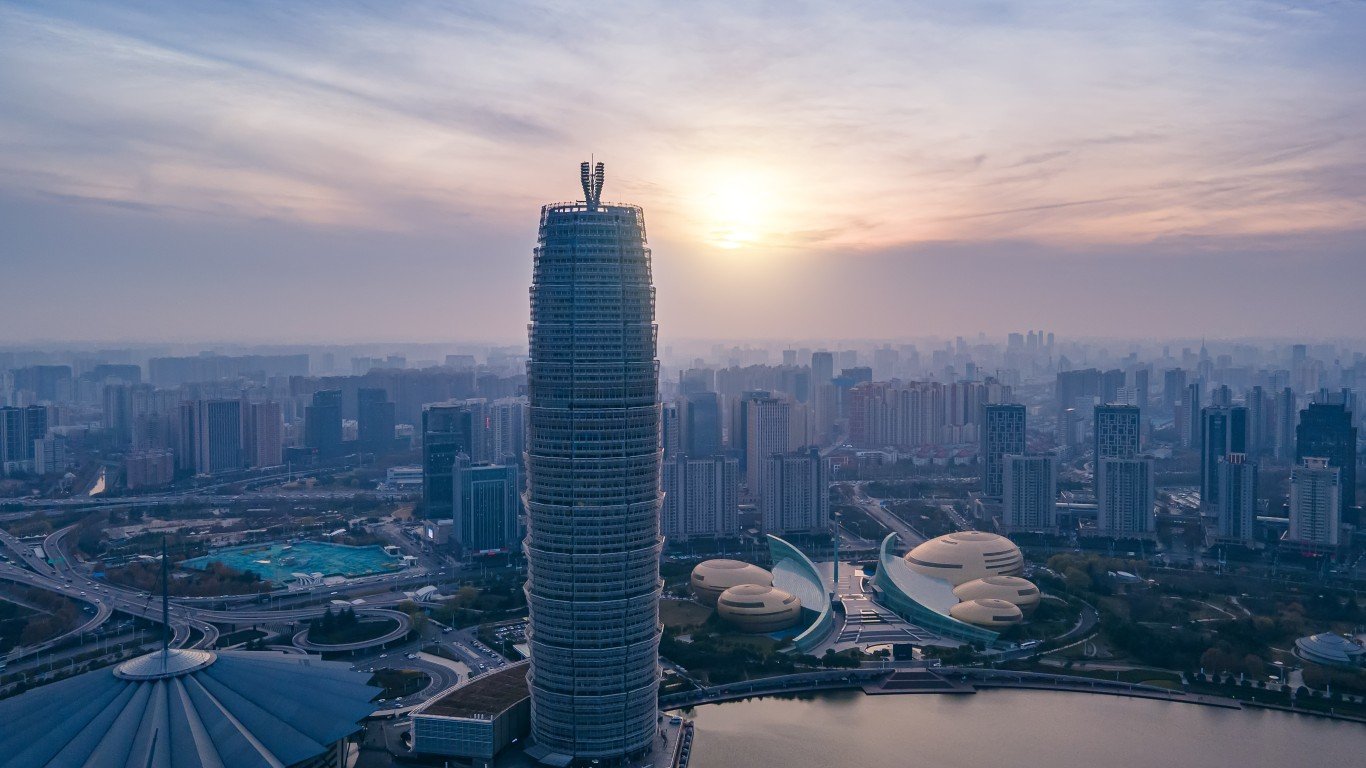
- Estimated population, 2023: 11,068,000
- Built up urban area, 2023: 689 square miles (or 1,785 square km) — #62 largest of 986 urban areas
- Population density: 16,064 people per square mile — #336 densest of 986 urban areas
- Est. GDP, 2023: $144.00 billion — #99 largest metro economy
- World Bank geographical region: East Asia and Pacific
- Country class (World Bank): Upper middle income
36. Paris, France
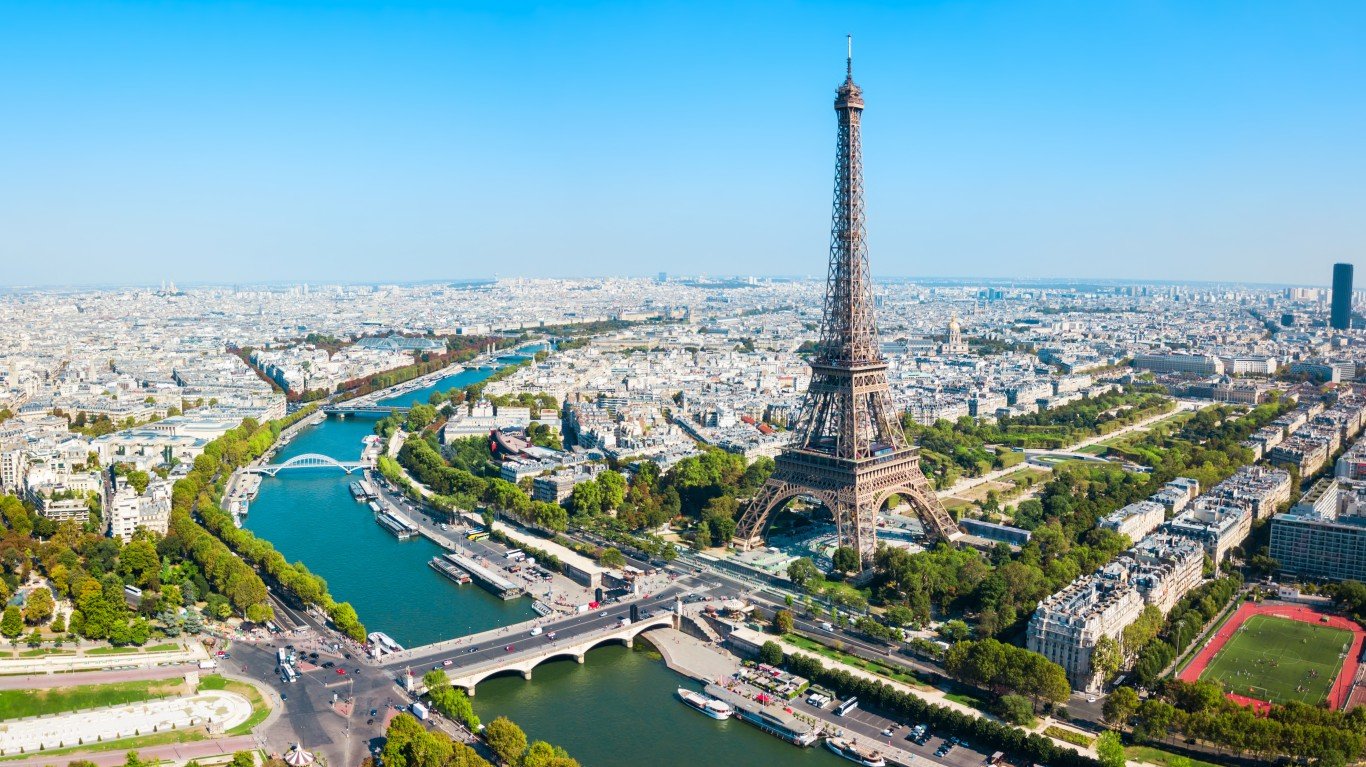
- Estimated population, 2023: 11,108,000
- Built up urban area, 2023: 1,102 square miles (or 2,854 square km) — #32 largest of 986 urban areas
- Population density: 10,084 people per square mile — #599 densest of 986 urban areas
- Est. GDP, 2023: $904.52 billion — #6 largest metro economy
- World Bank geographical region: Europe and Central Asia
- Country class (World Bank): High income
35. Chennai, TN, India
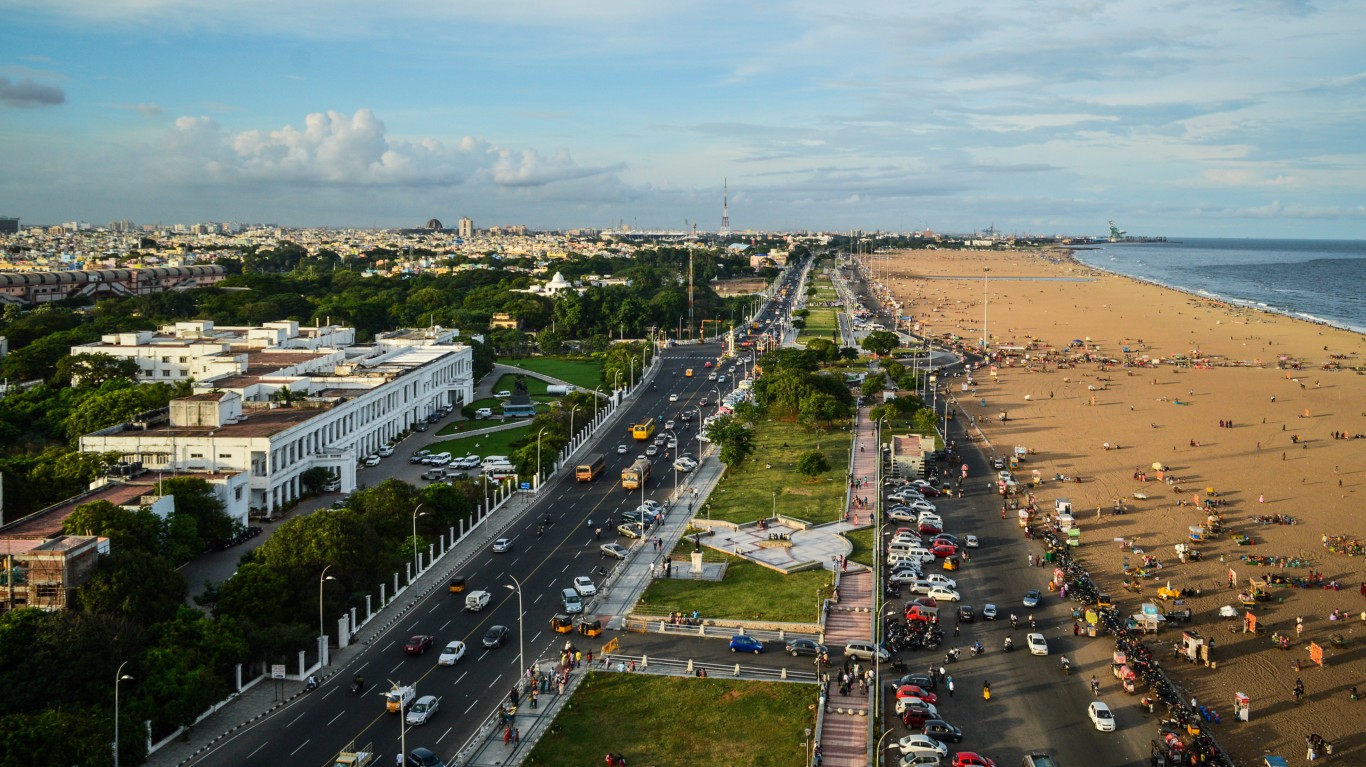
- Estimated population, 2023: 11,570,000
- Built up urban area, 2023: 473 square miles (or 1,225 square km) — #103 largest of 986 urban areas
- Population density: 24,461 people per square mile — #178 densest of 986 urban areas
- Est. GDP, 2023: $66.00 billion — #198 largest metro economy
- World Bank geographical region: South Asia
- Country class (World Bank): Lower middle income
34. Xi’an, SAA, China
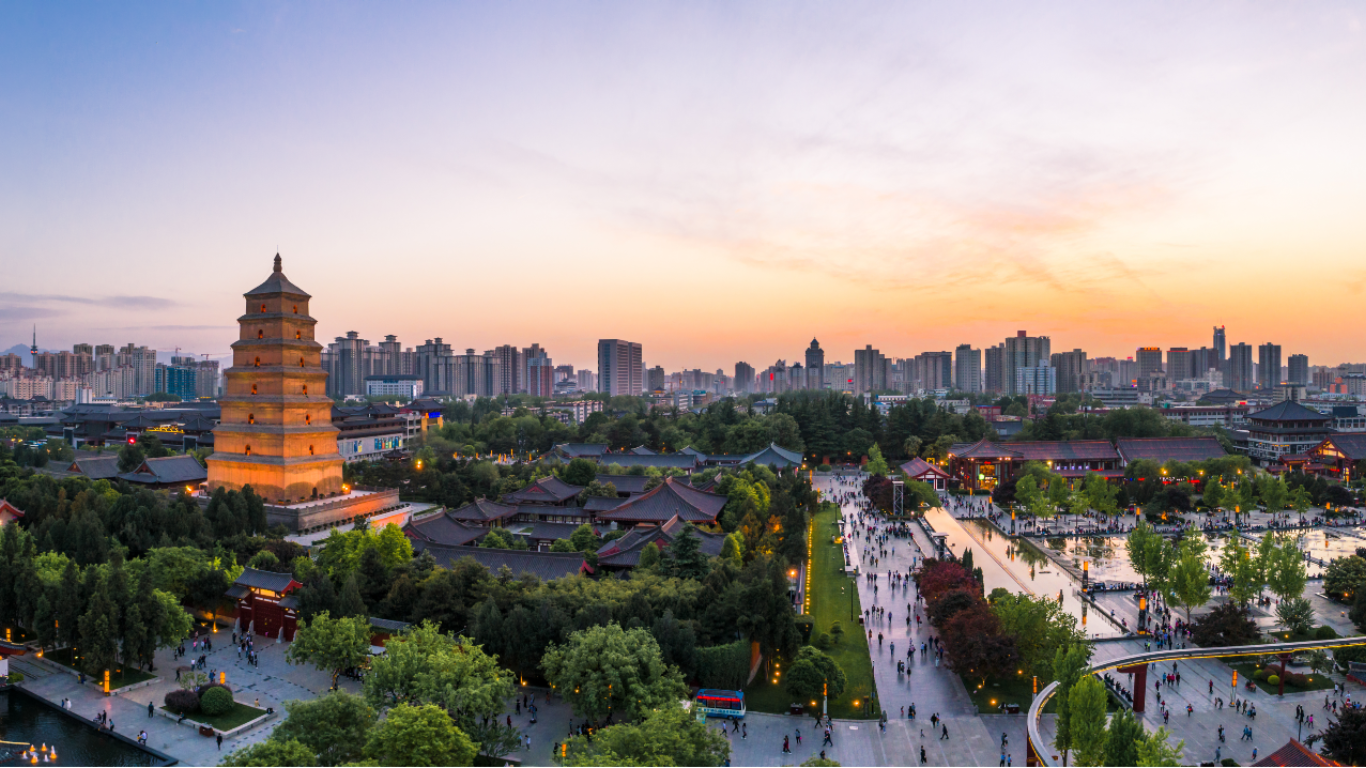
- Estimated population, 2023: 12,211,000
- Built up urban area, 2023: 705 square miles (or 1,826 square km) — #59 largest of 986 urban areas
- Population density: 17,321 people per square mile — #304 densest of 986 urban areas
- Est. GDP, 2023: $154.19 billion — #96 largest metro economy
- World Bank geographical region: East Asia and Pacific
- Country class (World Bank): Upper middle income
33. Rio de Janeiro, Brazil
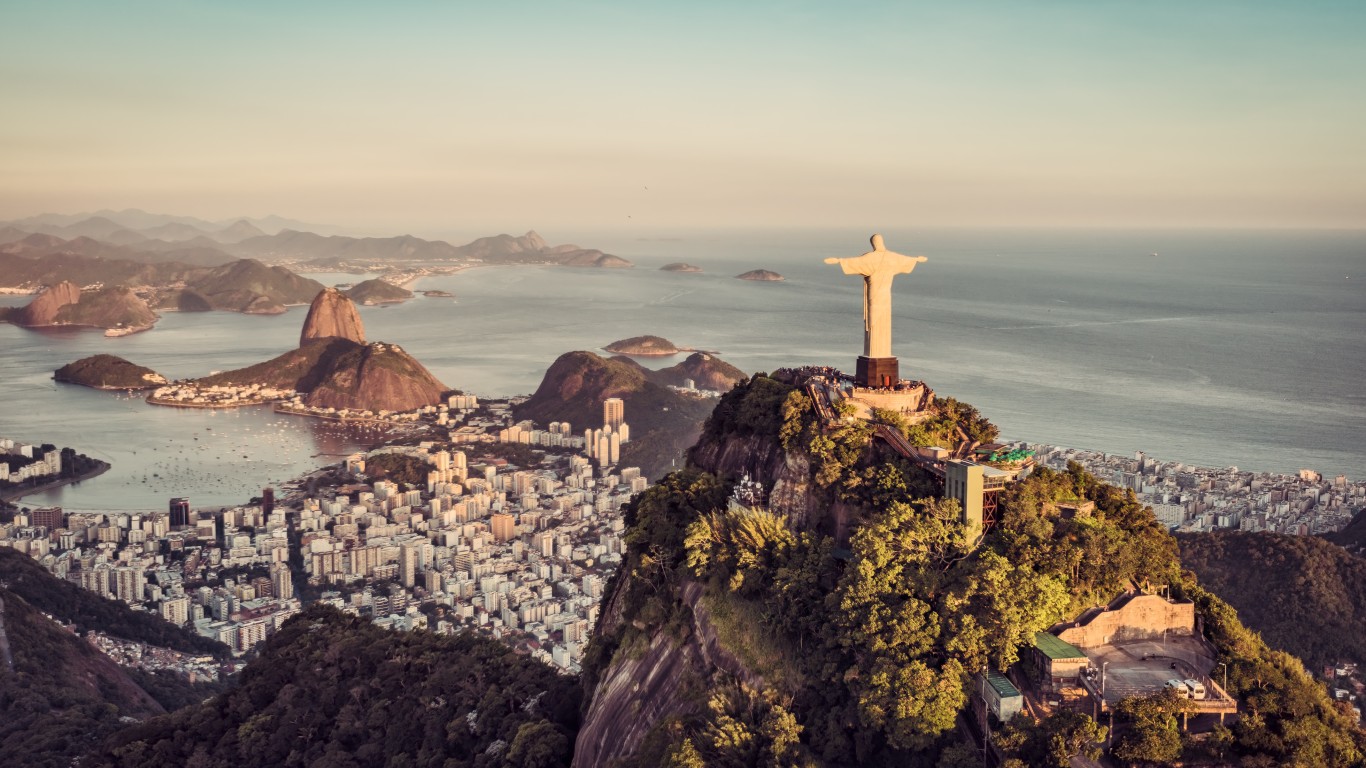
- Estimated population, 2023: 12,306,000
- Built up urban area, 2023: 780 square miles (or 2,020 square km) — #51 largest of 986 urban areas
- Population density: 15,777 people per square mile — #349 densest of 986 urban areas
- Est. GDP, 2023: $209.36 billion — #61 largest metro economy
- World Bank geographical region: Latin America and Caribbean
- Country class (World Bank): Upper middle income
32. Chongqing, CQ, China
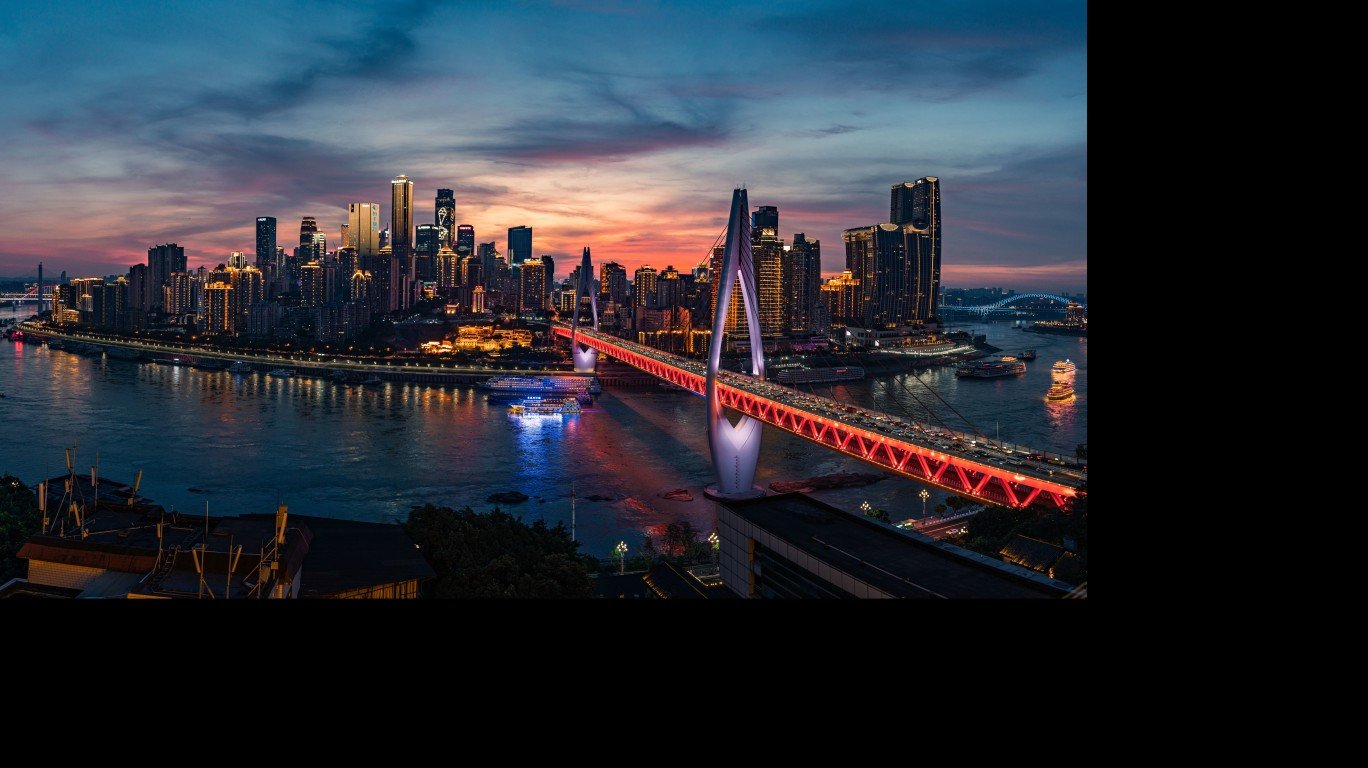
- Estimated population, 2023: 12,653,000
- Built up urban area, 2023: 610 square miles (or 1,580 square km) — #76 largest of 986 urban areas
- Population density: 20,743 people per square mile — #241 densest of 986 urban areas
- Est. GDP, 2023: $407.56 billion — #26 largest metro economy
- World Bank geographical region: East Asia and Pacific
- Country class (World Bank): Upper middle income
31. Tehran, Iran
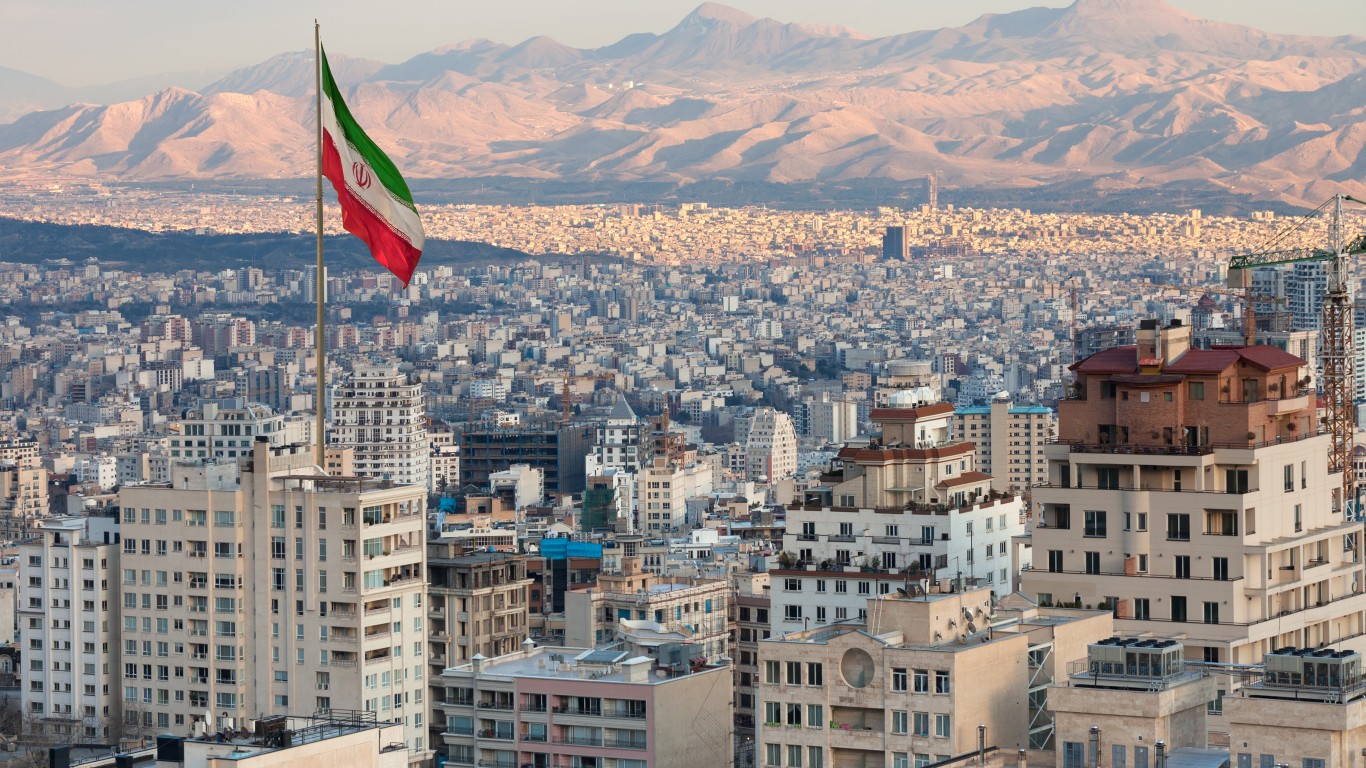
- Estimated population, 2023: 13,382,000
- Built up urban area, 2023: 658 square miles (or 1,704 square km) — #70 largest of 986 urban areas
- Population density: 20,337 people per square mile — #248 densest of 986 urban areas
- Est. GDP, 2023: N/A
- World Bank geographical region: Middle East and North Africa
- Country class (World Bank): Lower middle income
30. Kinshasa, Congo (Dem. Rep.)
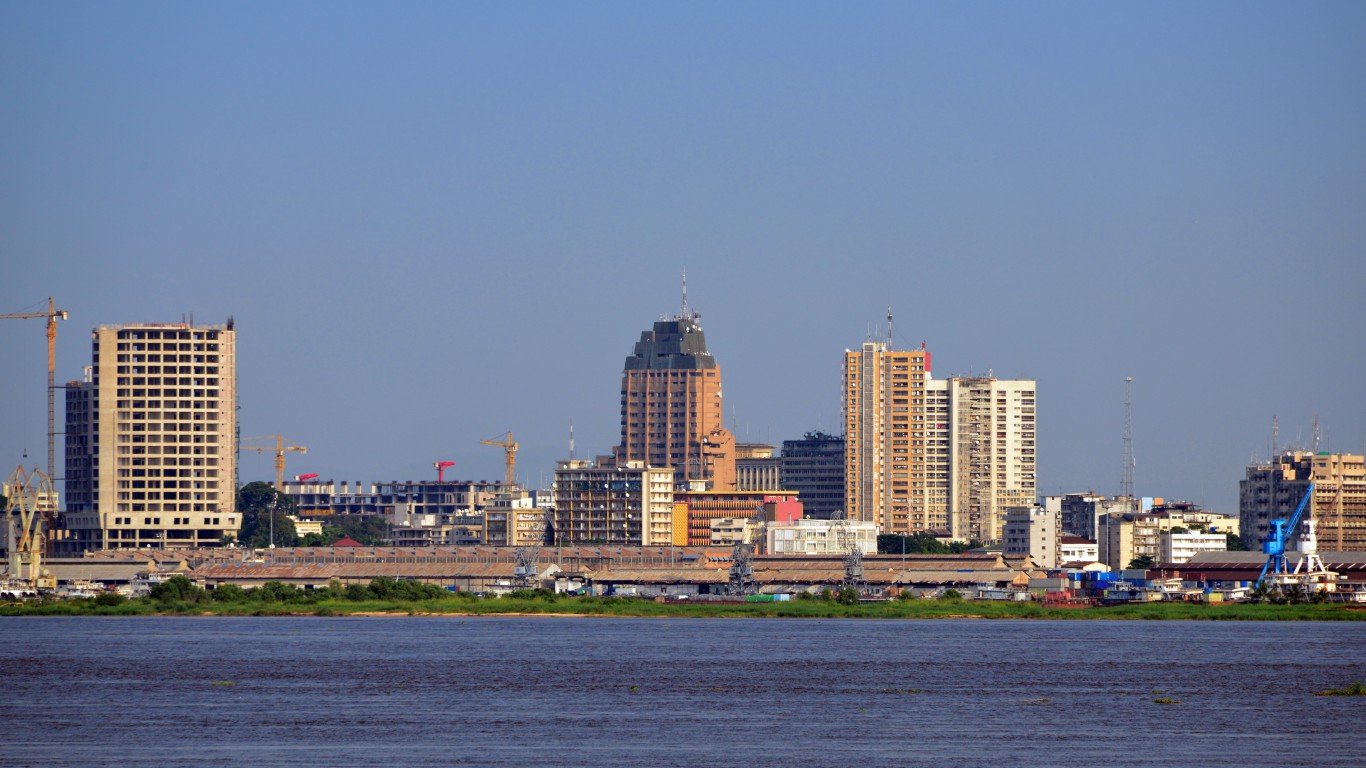
- Estimated population, 2023: 13,493,000
- Built up urban area, 2023: 200 square miles (or 518 square km) — #263 largest of 986 urban areas
- Population density: 67,465 people per square mile — #6 densest of 986 urban areas
- Est. GDP, 2023: N/A
- World Bank geographical region: Sub-Saharan Africa
- Country class (World Bank): Low income
29. Lahore, Pakistan
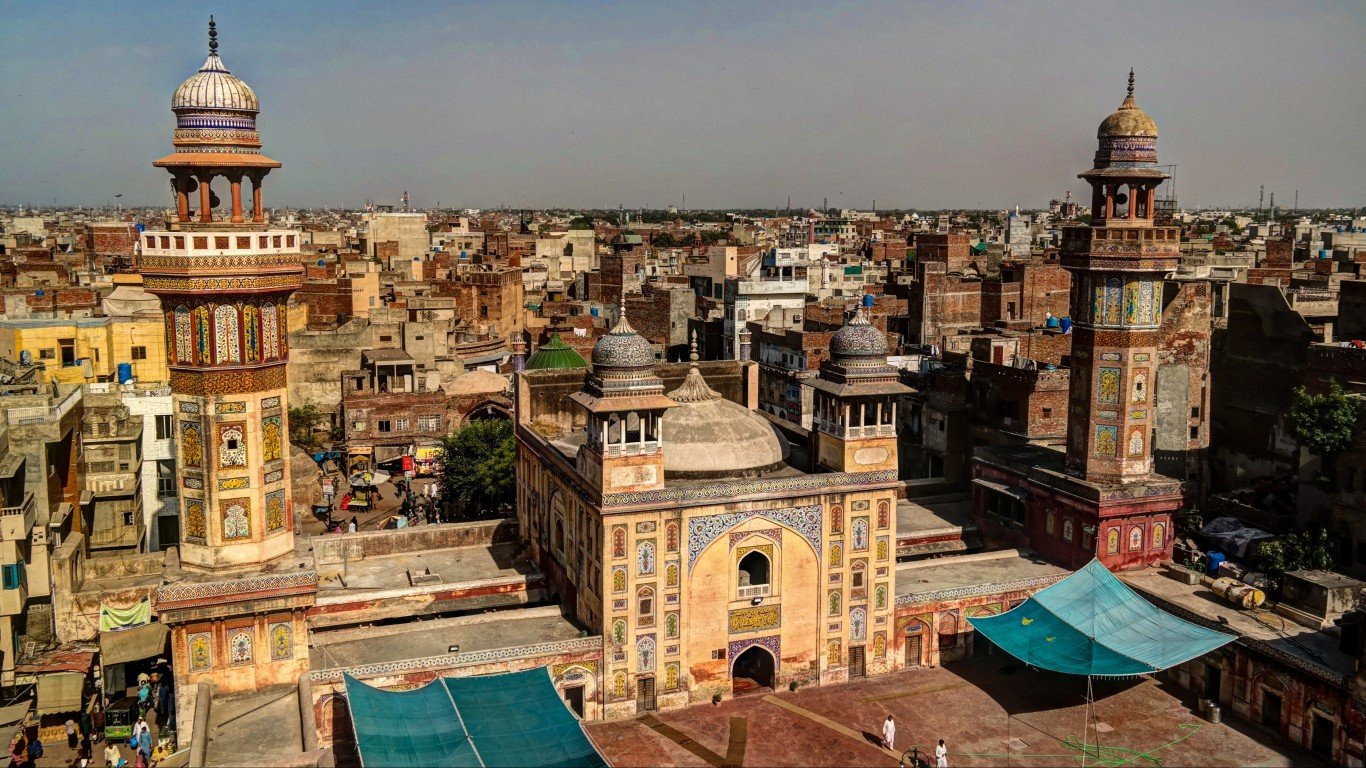
- Estimated population, 2023: 13,504,000
- Built up urban area, 2023: 365 square miles (or 945 square km) — #138 largest of 986 urban areas
- Population density: 36,997 people per square mile — #73 densest of 986 urban areas
- Est. GDP, 2023: $93.40 billion — #221 largest metro economy
- World Bank geographical region: South Asia
- Country class (World Bank): Lower middle income
28. Istanbul, Turkey
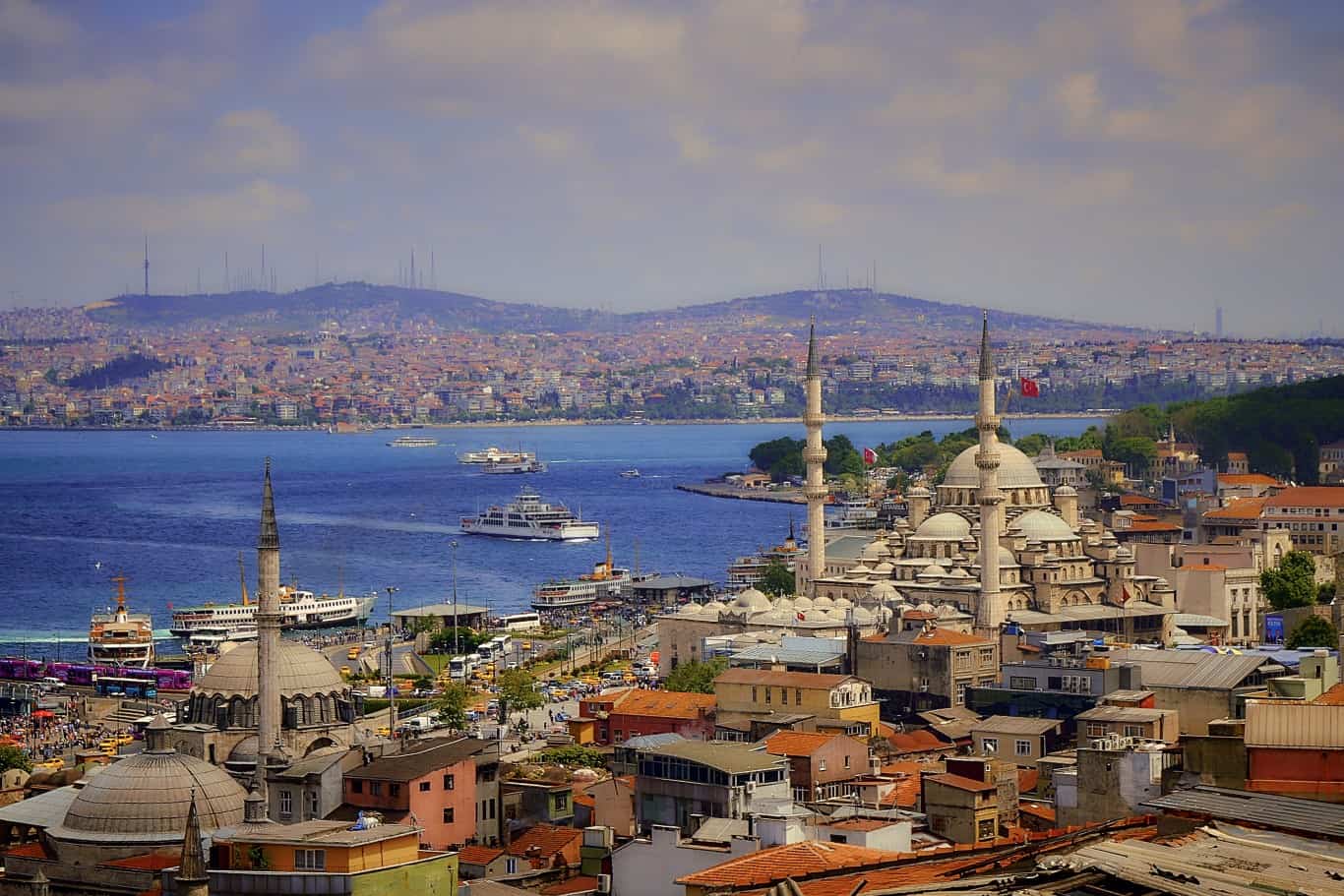
- Estimated population, 2023: 14,441,000
- Built up urban area, 2023: 568 square miles (or 1,471 square km) — #83 largest of 986 urban areas
- Population density: 25,424 people per square mile — #166 densest of 986 urban areas
- Est. GDP, 2023: $247.31 billion — #50 largest metro economy
- World Bank geographical region: Europe and Central Asia
- Country class (World Bank): Upper middle income
27. Lagos, Nigeria
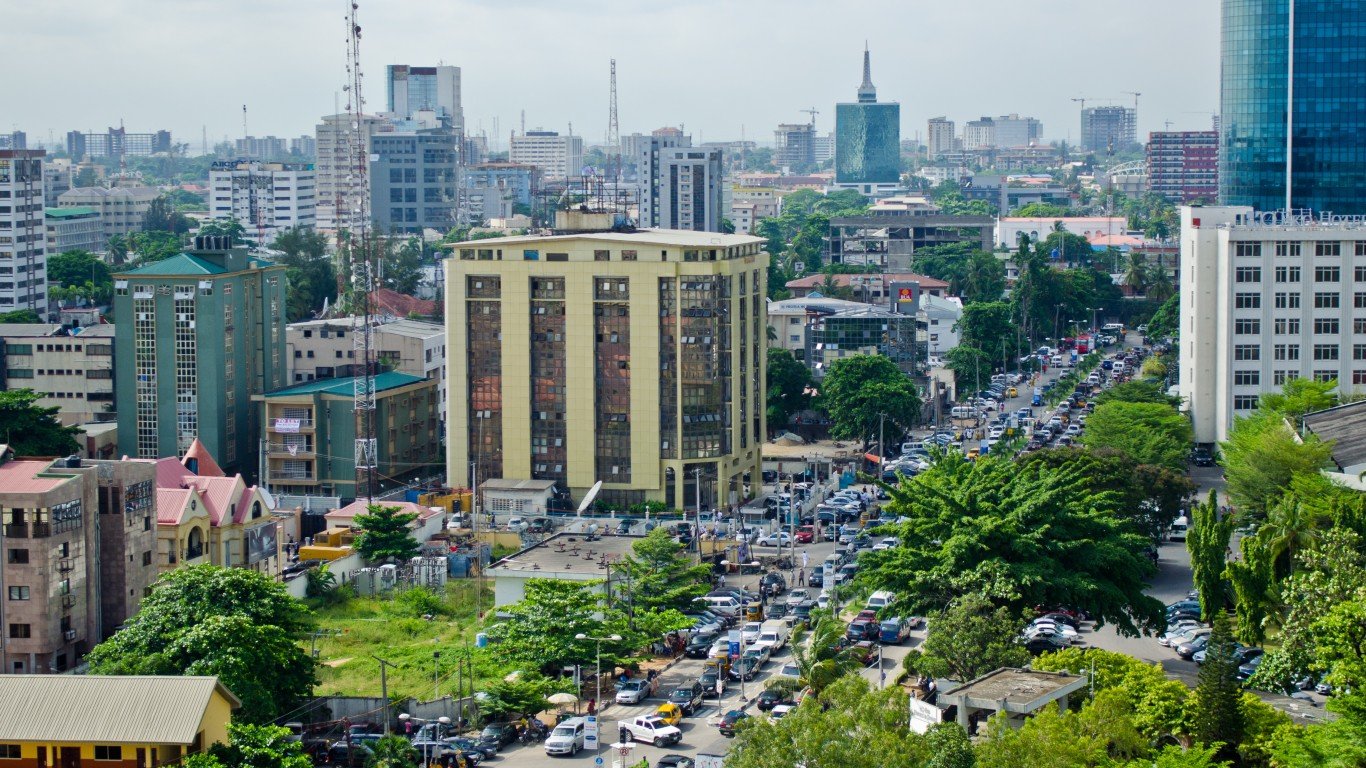
- Estimated population, 2023: 14,540,000
- Built up urban area, 2023: 998 square miles (or 2,585 square km) — #38 largest of 986 urban areas
- Population density: 14,569 people per square mile — #394 densest of 986 urban areas
- Est. GDP, 2023: $74.67 billion — #178 largest metro economy
- World Bank geographical region: Sub-Saharan Africa
- Country class (World Bank): Lower middle income
26. Osaka-Kobe-Kyoto, Japan
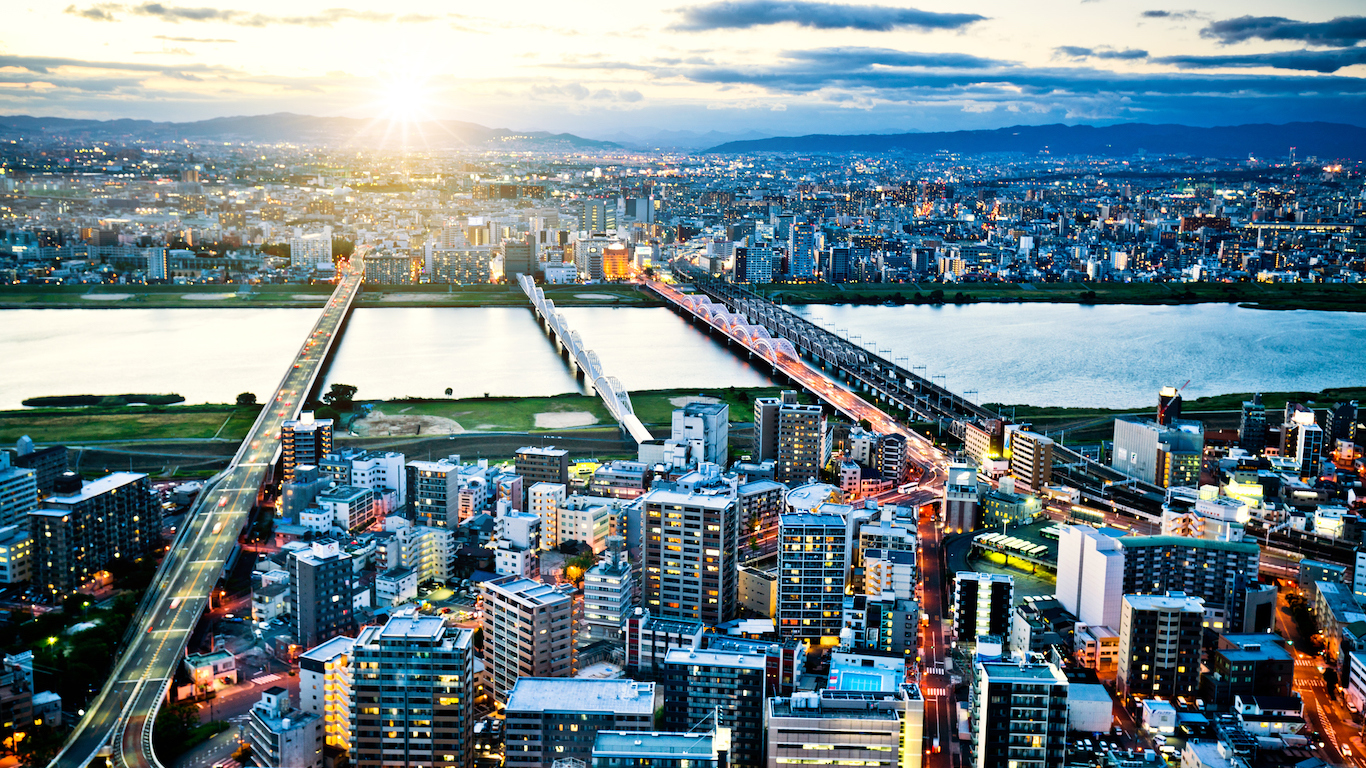
- Estimated population, 2023: 14,916,000
- Built up urban area, 2023: 1,166 square miles (or 3,020 square km) — #29 largest of 986 urban areas
- Population density: 12,792 people per square mile — #461 densest of 986 urban areas
- Est. GDP, 2023: $699.47 billion — #8 largest metro economy
- World Bank geographical region: East Asia and Pacific
- Country class (World Bank): High income
25. Ho Chi Minh City, Vietnam
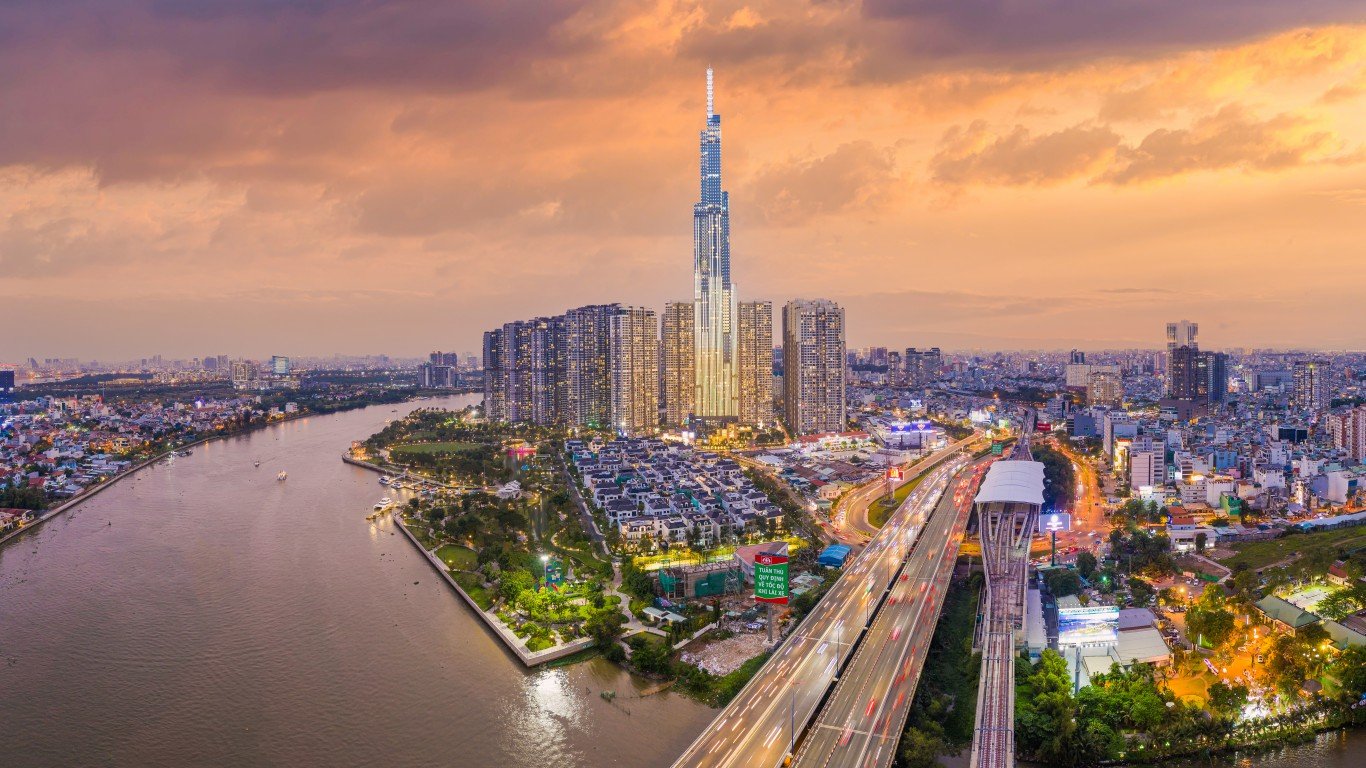
- Estimated population, 2023: 14,953,000
- Built up urban area, 2023: 836 square miles (or 2,165 square km) — #49 largest of 986 urban areas
- Population density: 17,886 people per square mile — #291 densest of 986 urban areas
- Est. GDP, 2023: $96.39 billion — #141 largest metro economy
- World Bank geographical region: East Asia and Pacific
- Country class (World Bank): Lower middle income
24. Chengdu, SC, China
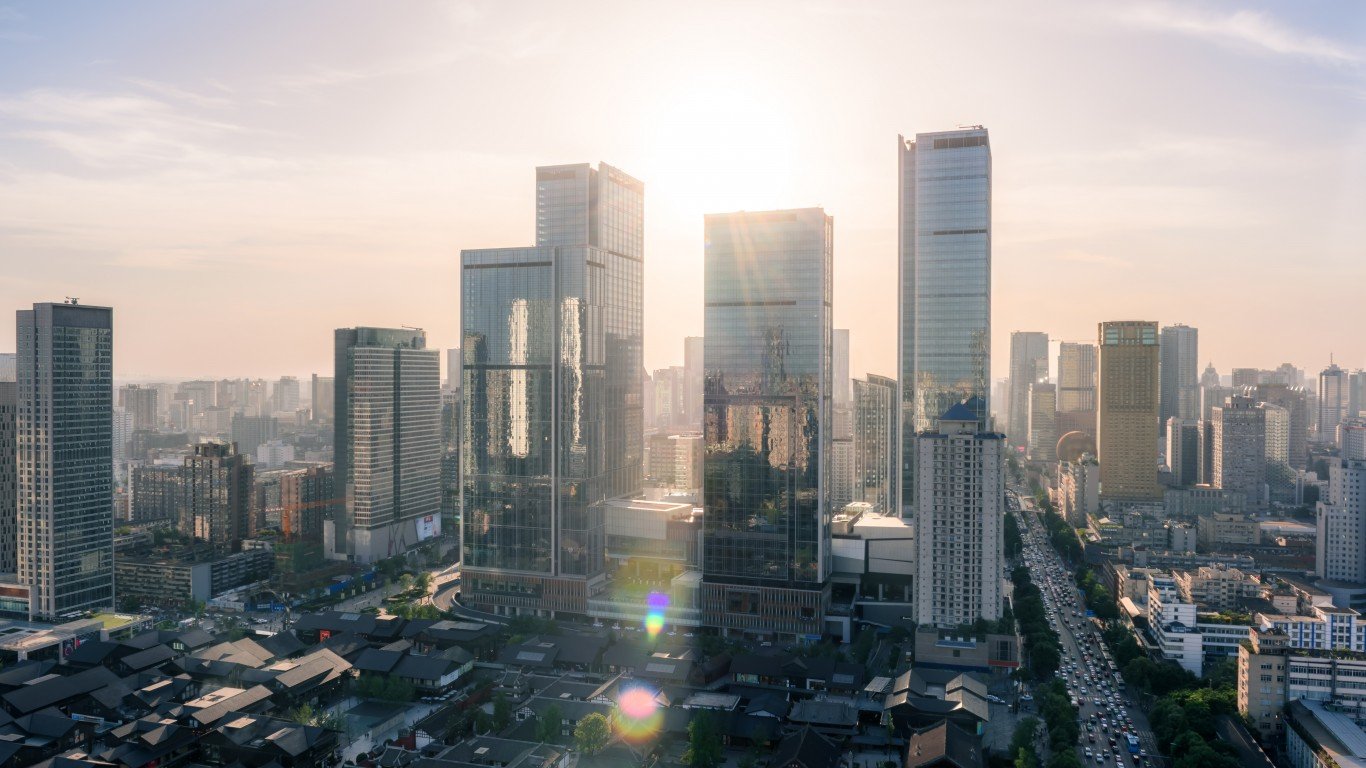
- Estimated population, 2023: 15,016,000
- Built up urban area, 2023: 747 square miles (or 1,935 square km) — #55 largest of 986 urban areas
- Population density: 20,102 people per square mile — #251 densest of 986 urban areas
- Est. GDP, 2023: $260.39 billion — #42 largest metro economy
- World Bank geographical region: East Asia and Pacific
- Country class (World Bank): Upper middle income
23. Bangalore, KA, India
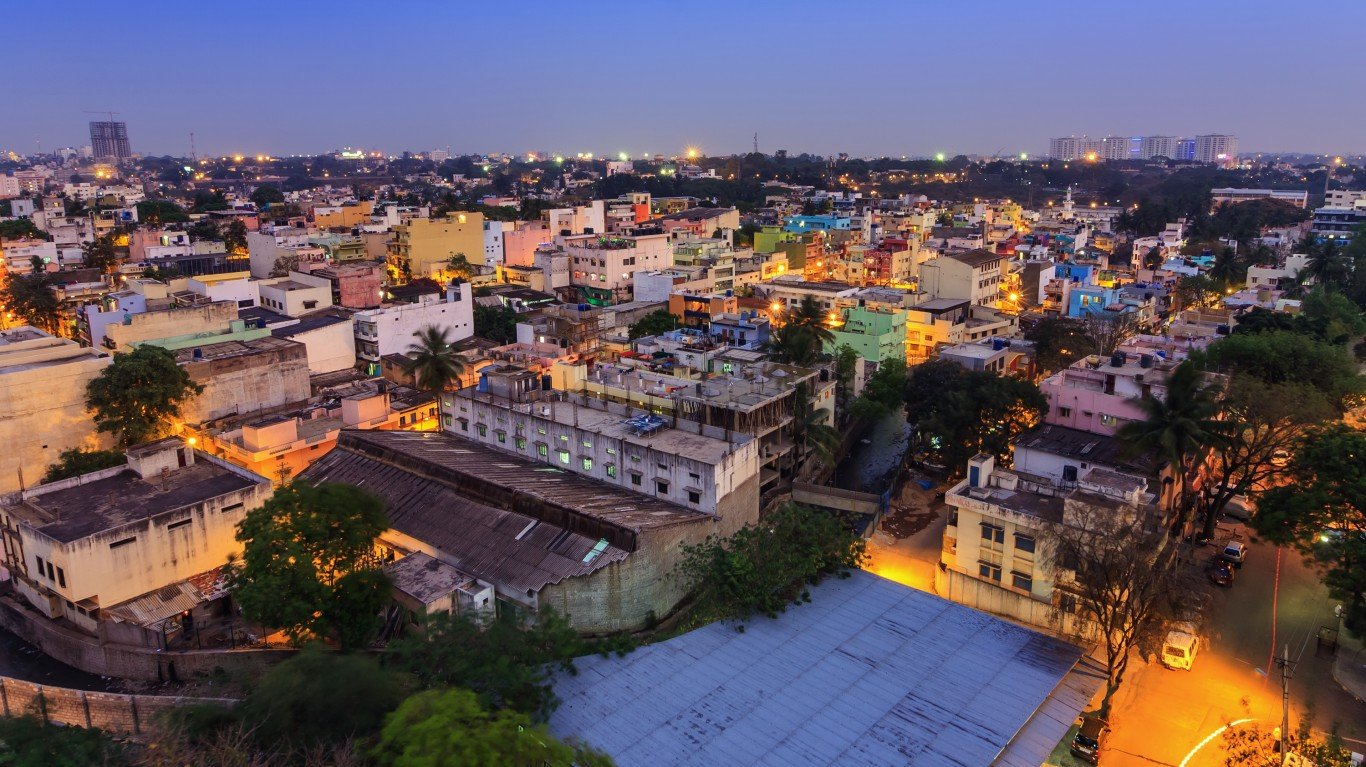
- Estimated population, 2023: 15,257,000
- Built up urban area, 2023: 673 square miles (or 1,743 square km) — #67 largest of 986 urban areas
- Population density: 22,670 people per square mile — #204 densest of 986 urban areas
- Est. GDP, 2023: N/A
- World Bank geographical region: South Asia
- Country class (World Bank): Lower middle income
22. Johannesburg-Pretoria, South Africa
- Estimated population, 2023: 15,551,000
- Built up urban area, 2023: 1,560 square miles (or 4,040 square km) — #16 largest of 986 urban areas
- Population density: 9,969 people per square mile — #605 densest of 986 urban areas
- Est. GDP, 2023: $76.00 billion — #176 largest metro economy
- World Bank geographical region: Sub-Saharan Africa
- Country class (World Bank): Upper middle income
21. Los Angeles, CA, United States

- Estimated population, 2023: 15,587,000
- Built up urban area, 2023: 2,671 square miles (or 6,918 square km) — #5 largest of 986 urban areas
- Population density: 5,835 people per square mile — #852 densest of 986 urban areas
- Est. GDP, 2023: $1,124.68 billion — #3 largest metro economy
- World Bank geographical region: North America
- Country class (World Bank): High income
20. Buenos Aires, Argentina
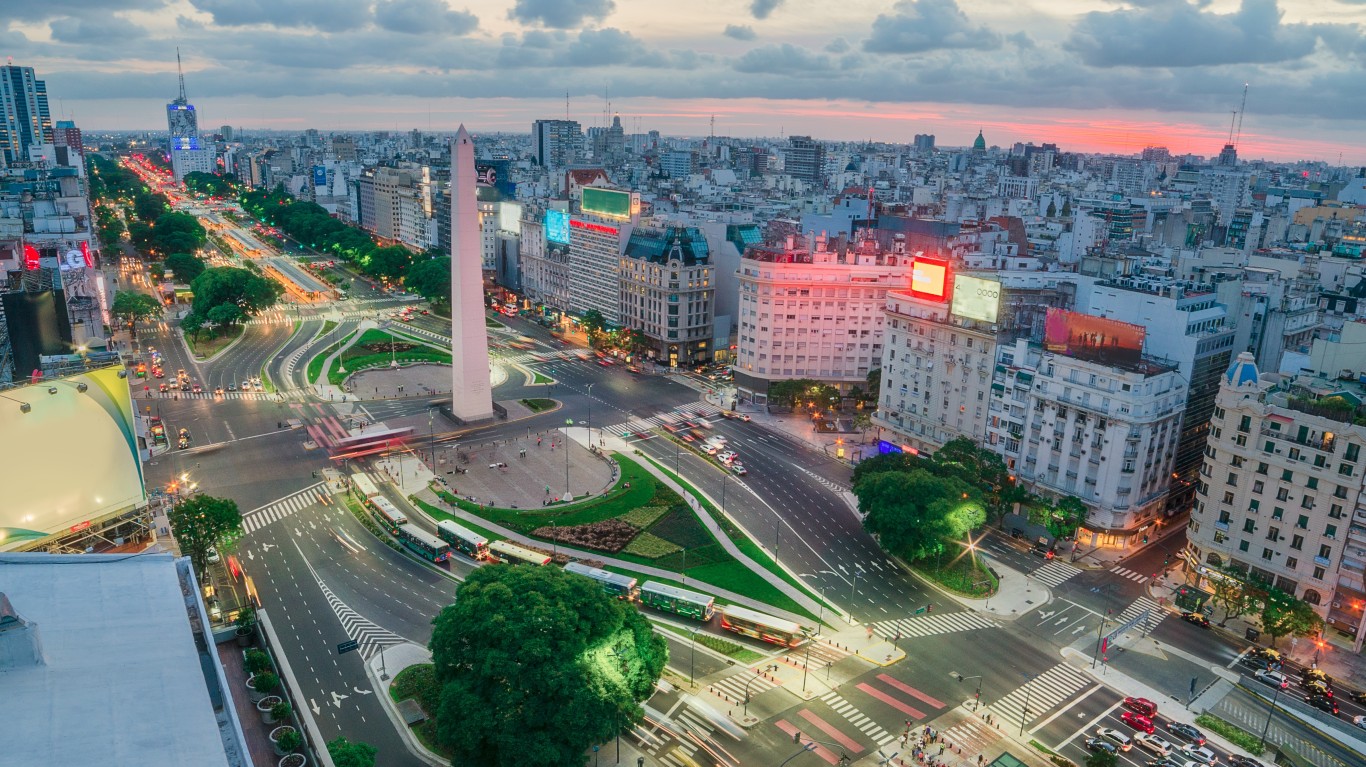
- Estimated population, 2023: 15,748,000
- Built up urban area, 2023: 1,327 square miles (or 3,437 square km) — #23 largest of 986 urban areas
- Population density: 11,867 people per square mile — #501 densest of 986 urban areas
- Est. GDP, 2023: $84.70 billion — #157 largest metro economy
- World Bank geographical region: Latin America and Caribbean
- Country class (World Bank): Upper middle income
19. Shenzhen, GD, China
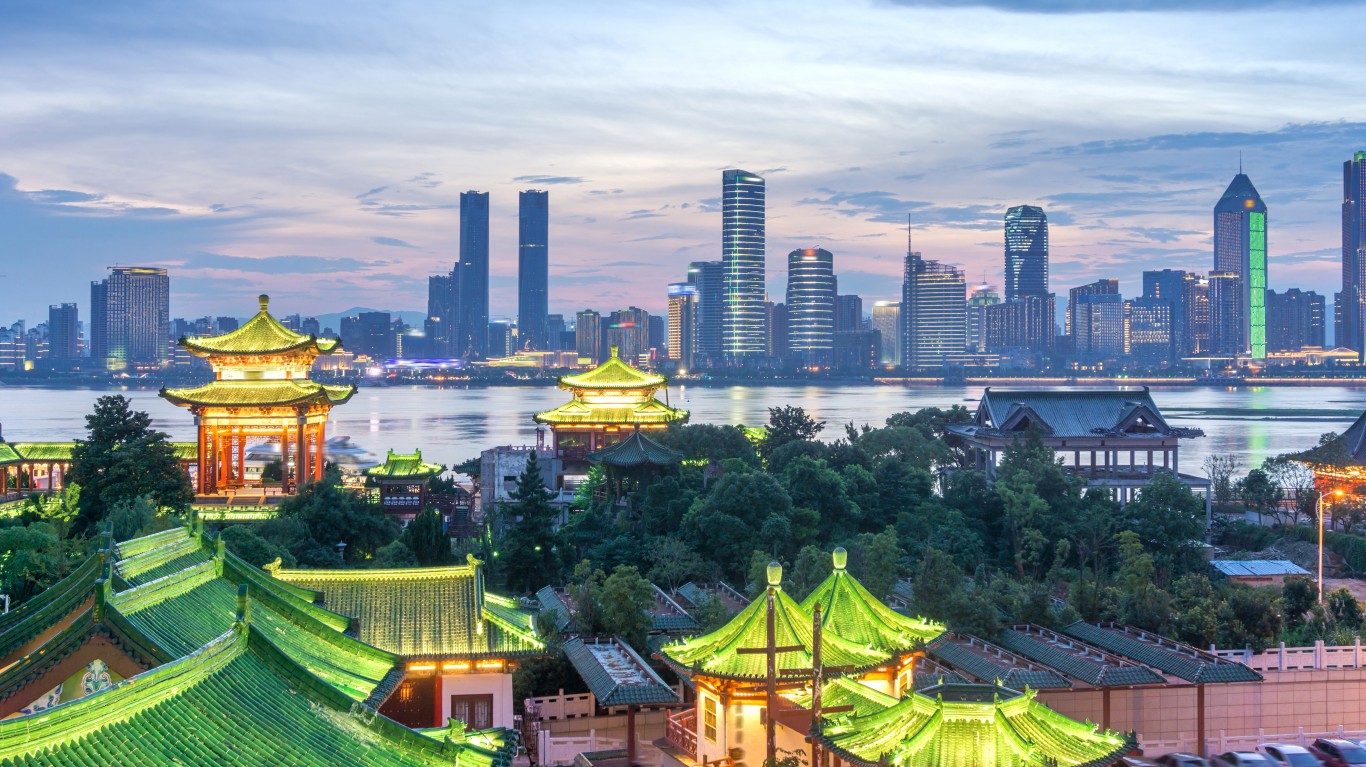
- Estimated population, 2023: 17,778,000
- Built up urban area, 2023: 698 square miles (or 1,808 square km) — #61 largest of 986 urban areas
- Population density: 25,470 people per square mile — #165 densest of 986 urban areas
- Est. GDP, 2023: $455.69 billion — #21 largest metro economy
- World Bank geographical region: East Asia and Pacific
- Country class (World Bank): Upper middle income
18. Moscow, Russia
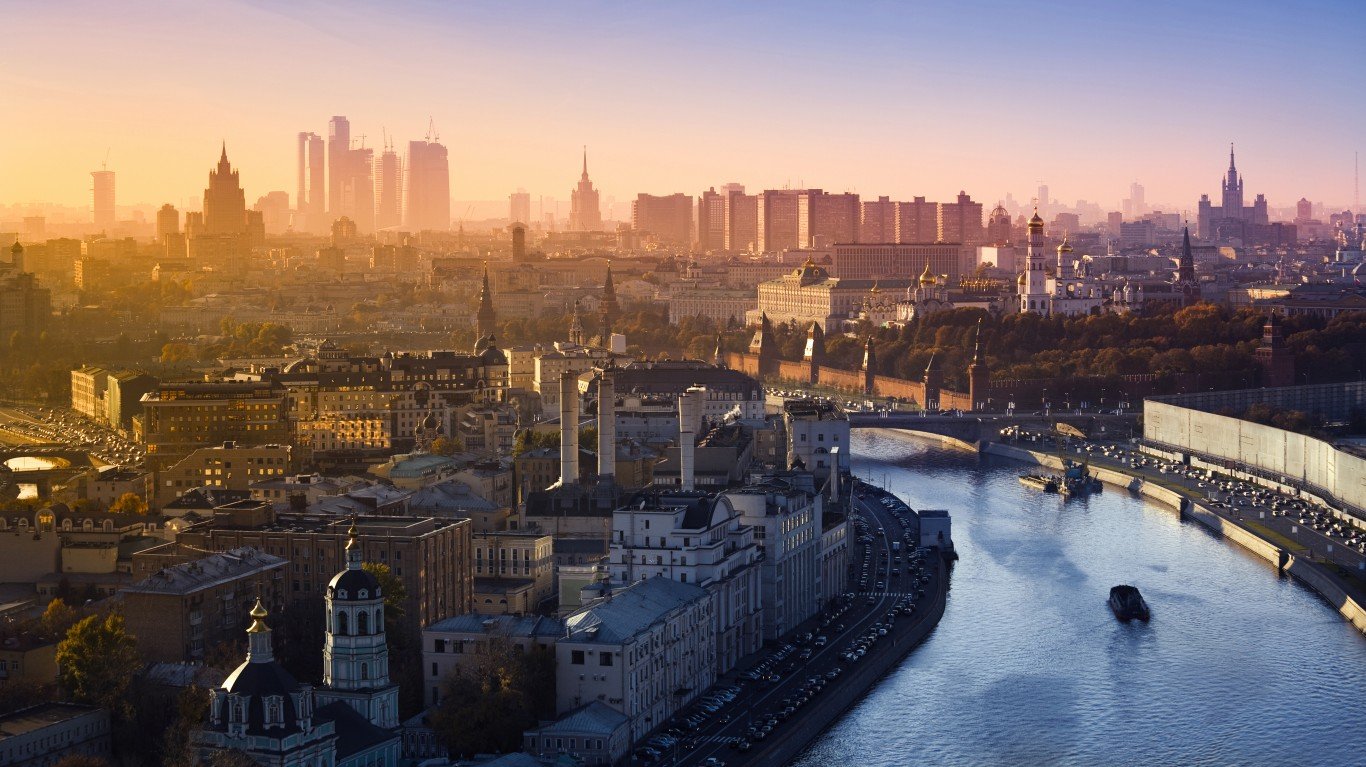
- Estimated population, 2023: 17,878,000
- Built up urban area, 2023: 2,565 square miles (or 6,643 square km) — #6 largest of 986 urban areas
- Population density: 6,970 people per square mile — #791 densest of 986 urban areas
- Est. GDP, 2023: $504.80 billion — #17 largest metro economy
- World Bank geographical region: Europe and Central Asia
- Country class (World Bank): Upper middle income
17. Beijing, BJ-HEB, China
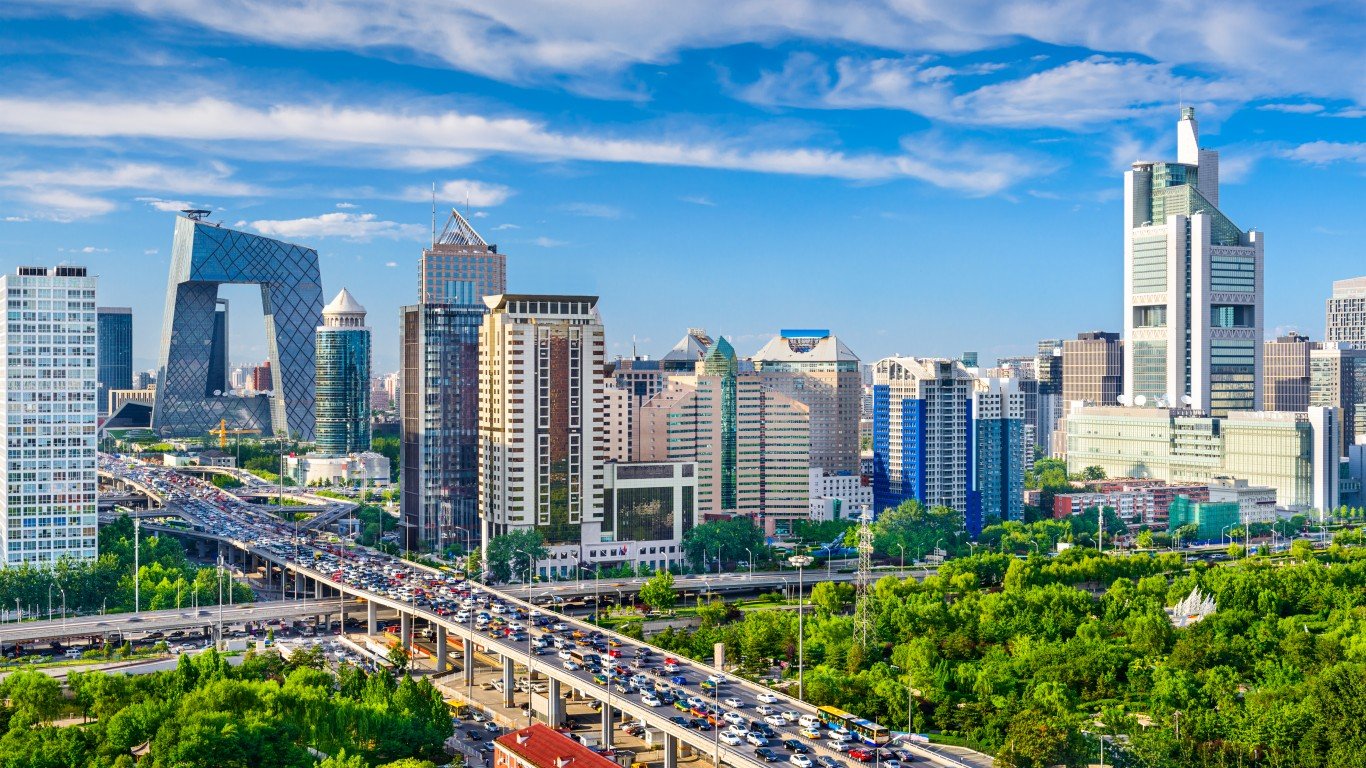
- Estimated population, 2023: 18,883,000
- Built up urban area, 2023: 1,654 square miles (or 4,284 square km) — #14 largest of 986 urban areas
- Population density: 11,417 people per square mile — #526 densest of 986 urban areas
- Est. GDP, 2023: $618.64 billion — #11 largest metro economy
- World Bank geographical region: East Asia and Pacific
- Country class (World Bank): Upper middle income
16. Bangkok, Thailand
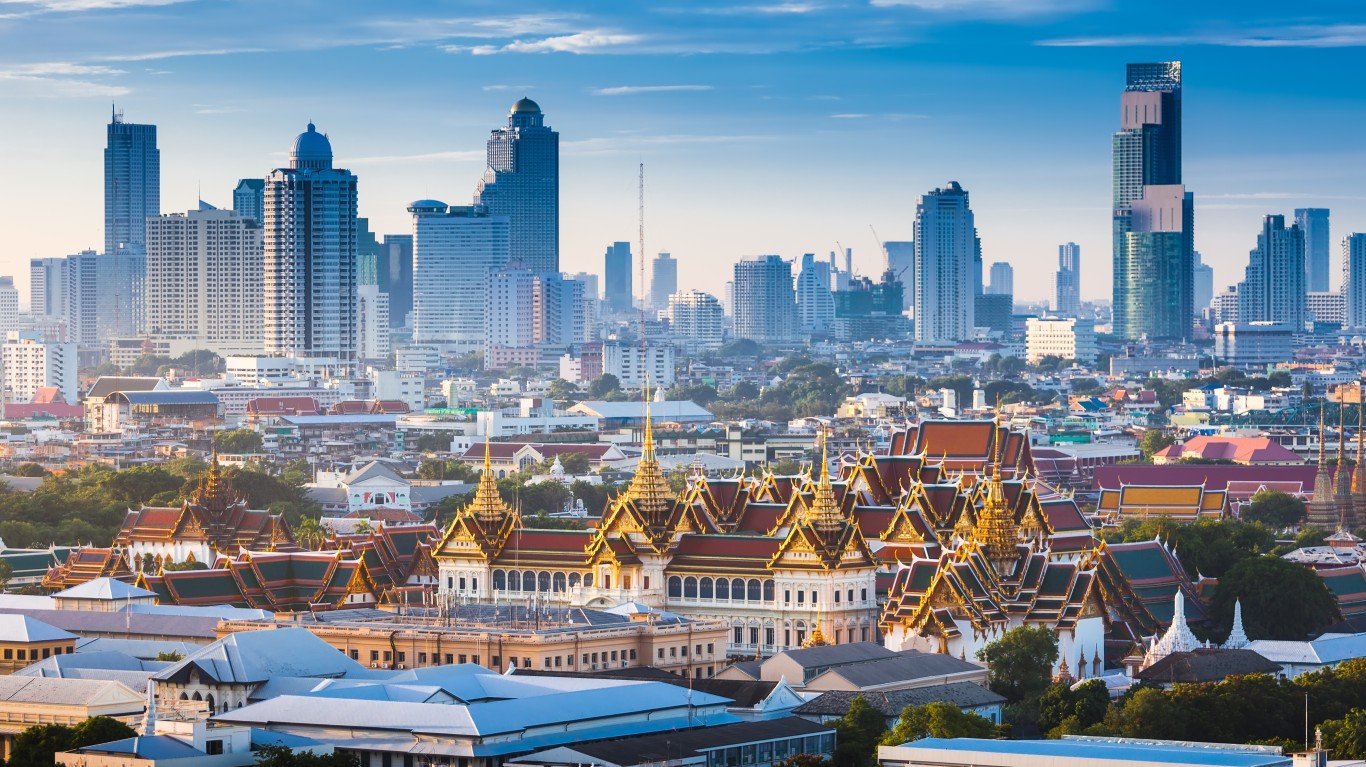
- Estimated population, 2023: 18,884,000
- Built up urban area, 2023: 1,235 square miles (or 3,199 square km) — #26 largest of 986 urban areas
- Population density: 15,291 people per square mile — #368 densest of 986 urban areas
- Est. GDP, 2023: $252.12 billion — #46 largest metro economy
- World Bank geographical region: East Asia and Pacific
- Country class (World Bank): Upper middle income
15. Dhaka, Bangladesh
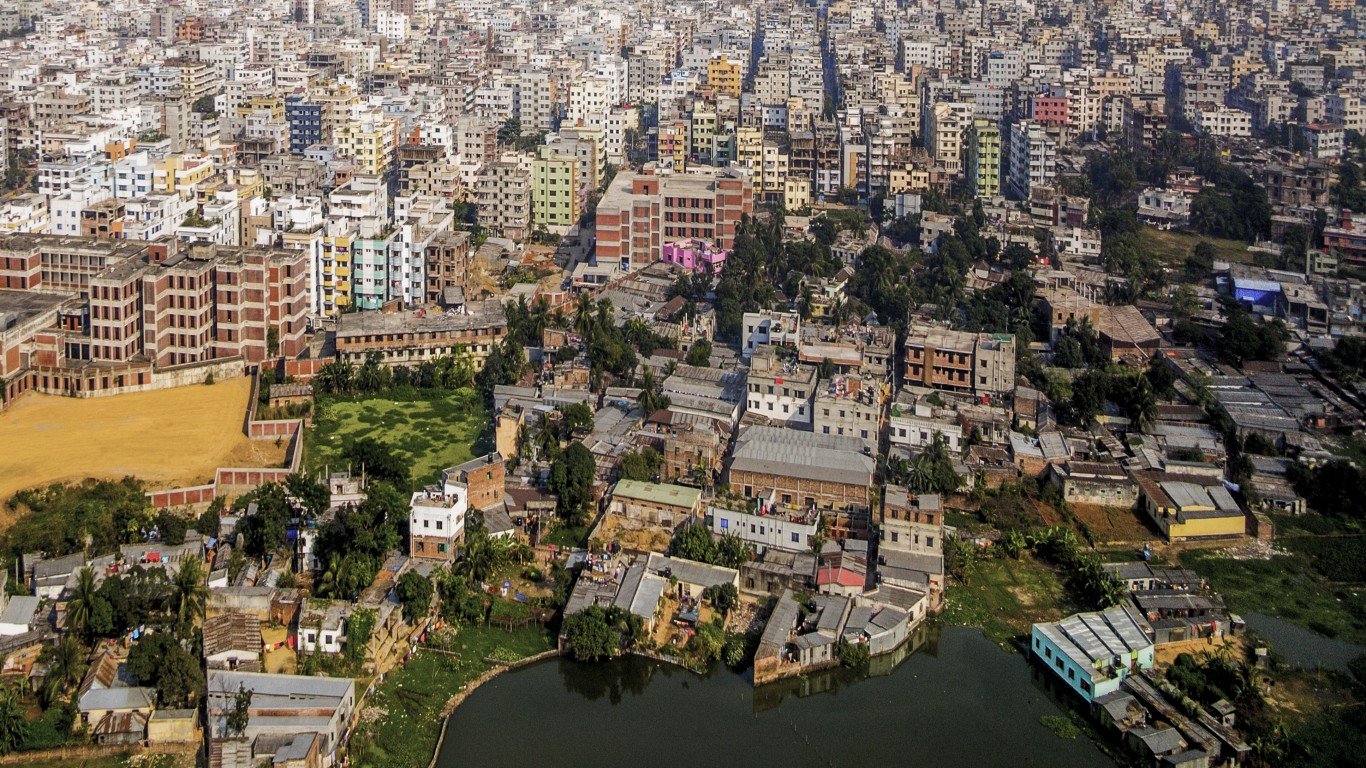
- Estimated population, 2023: 19,134,000
- Built up urban area, 2023: 239 square miles (or 619 square km) — #220 largest of 986 urban areas
- Population density: 80,059 people per square mile — #3 densest of 986 urban areas
- Est. GDP, 2023: $160.00 billion — #91 largest metro economy
- World Bank geographical region: South Asia
- Country class (World Bank): Lower middle income
14. Karachi, Pakistan
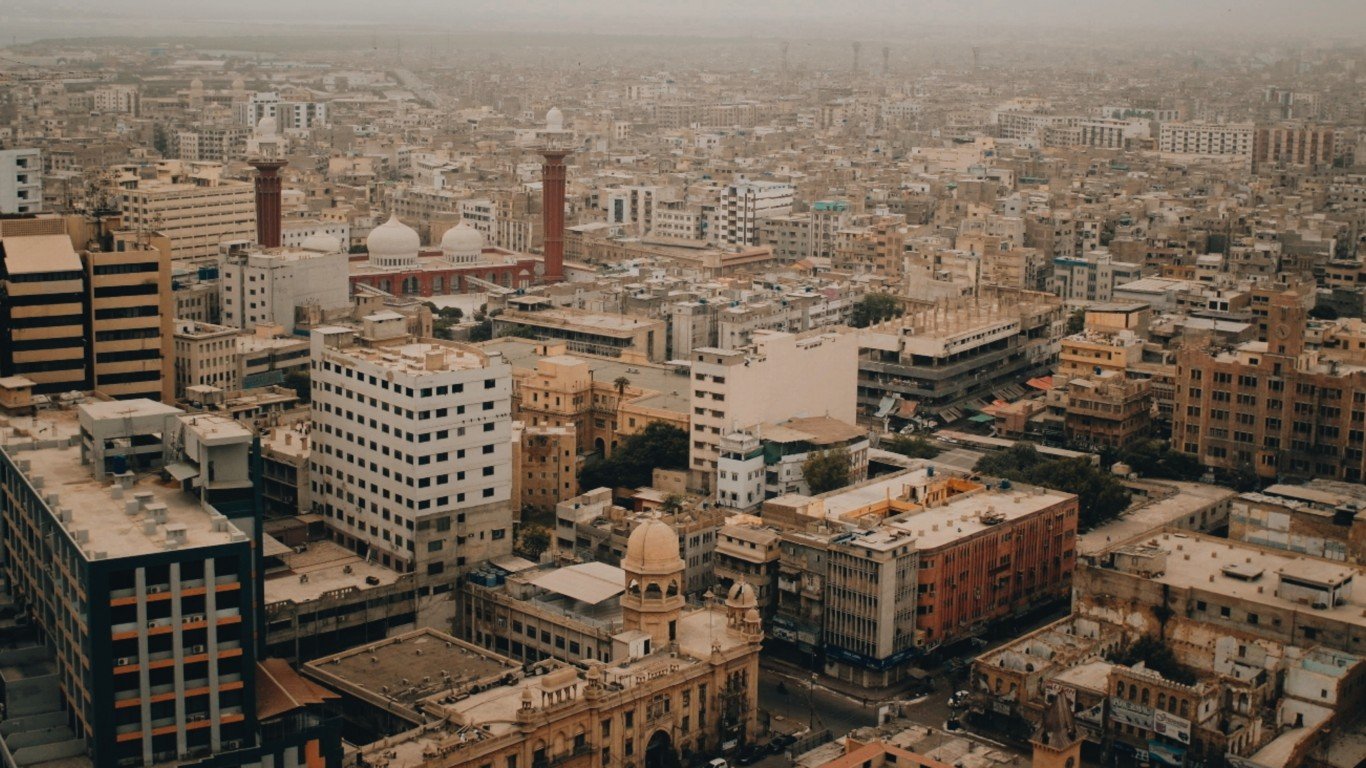
- Estimated population, 2023: 20,249,000
- Built up urban area, 2023: 434 square miles (or 1,124 square km) — #112 largest of 986 urban areas
- Population density: 46,657 people per square mile — #38 densest of 986 urban areas
- Est. GDP, 2023: $200.00 billion — #64 largest metro economy
- World Bank geographical region: South Asia
- Country class (World Bank): Lower middle income
13. New York, NY-NJ-CT, United States
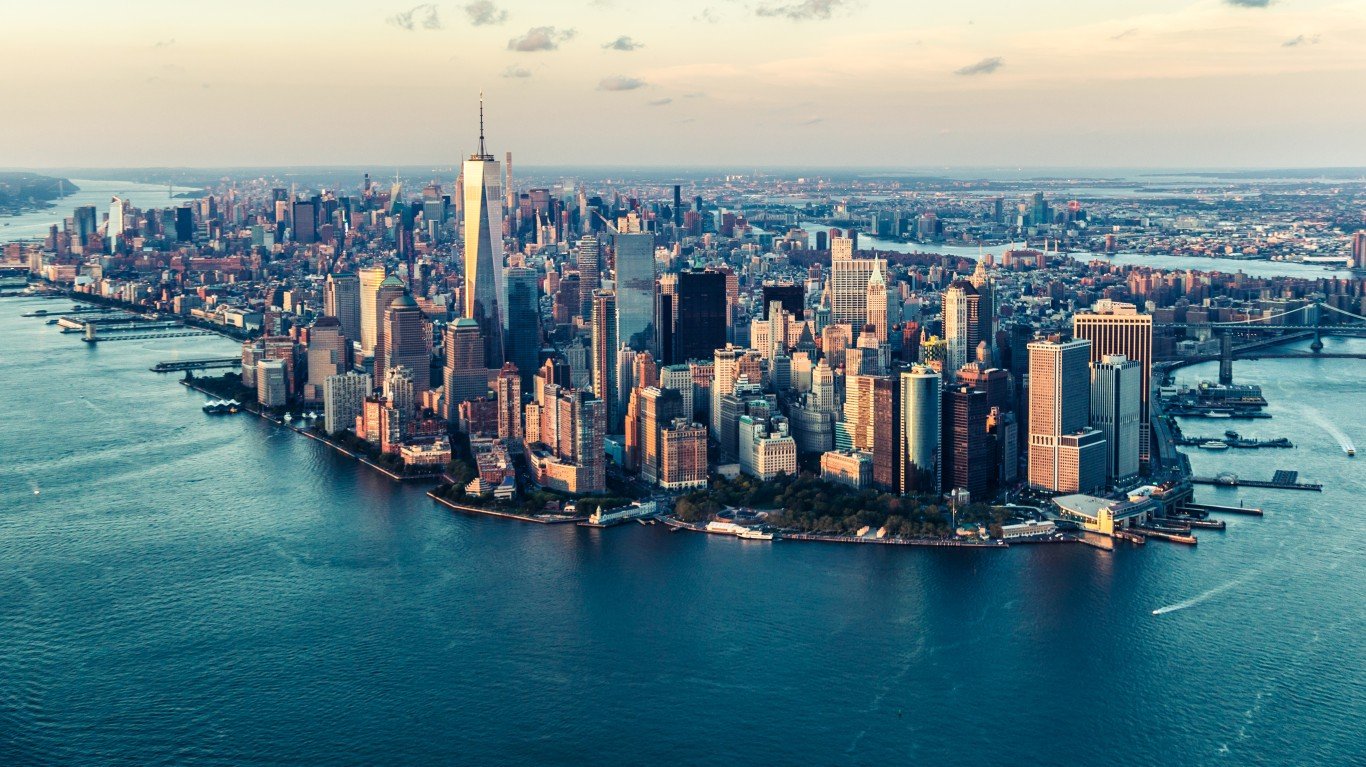
- Estimated population, 2023: 21,396,000
- Built up urban area, 2023: 4,380 square miles (or 11,344 square km) — #1 largest of 986 urban areas
- Population density: 4,884 people per square mile — #895 densest of 986 urban areas
- Est. GDP, 2023: $1,992.77 billion — #2 largest metro economy
- World Bank geographical region: North America
- Country class (World Bank): High income
12. Sao Paulo, Brazil
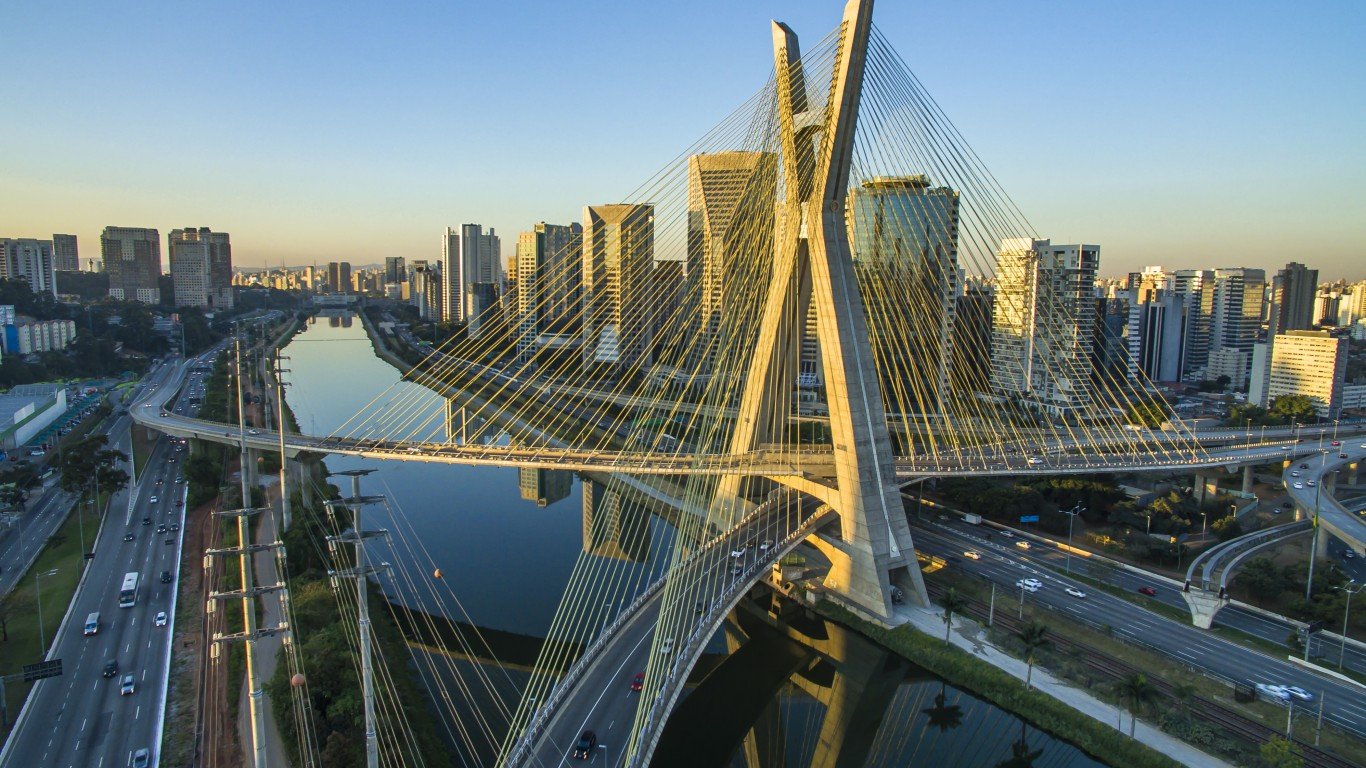
- Estimated population, 2023: 21,486,000
- Built up urban area, 2023: 1,409 square miles (or 3,649 square km) — #18 largest of 986 urban areas
- Population density: 15,249 people per square mile — #369 densest of 986 urban areas
- Est. GDP, 2023: $261.64 billion — #41 largest metro economy
- World Bank geographical region: Latin America and Caribbean
- Country class (World Bank): Upper middle income
11. Kolkata, WB, India
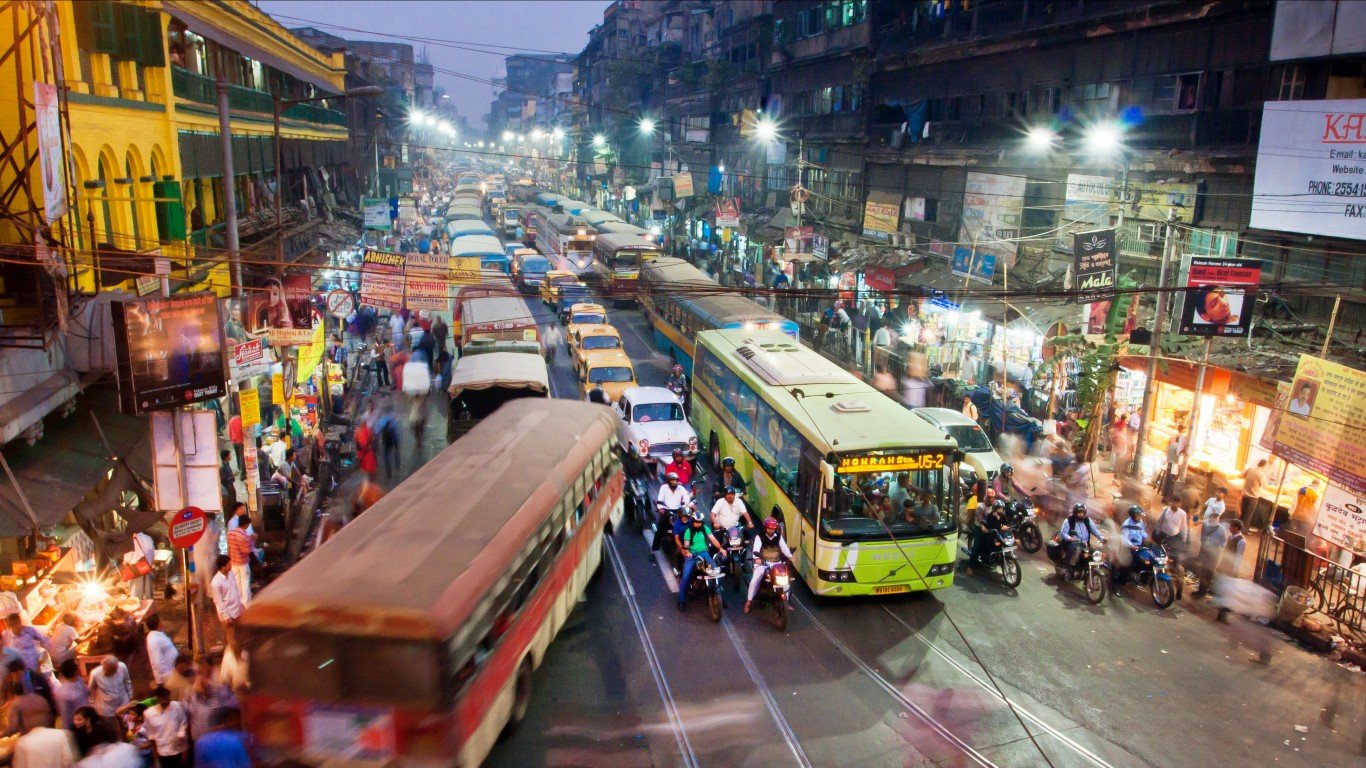
- Estimated population, 2023: 21,747,000
- Built up urban area, 2023: 522 square miles (or 1,352 square km) — #90 largest of 986 urban areas
- Population density: 41,661 people per square mile — #52 densest of 986 urban areas
- Est. GDP, 2023: $60.44 billion — #215 largest metro economy
- World Bank geographical region: South Asia
- Country class (World Bank): Lower middle income
10. Mexico City, Mexico
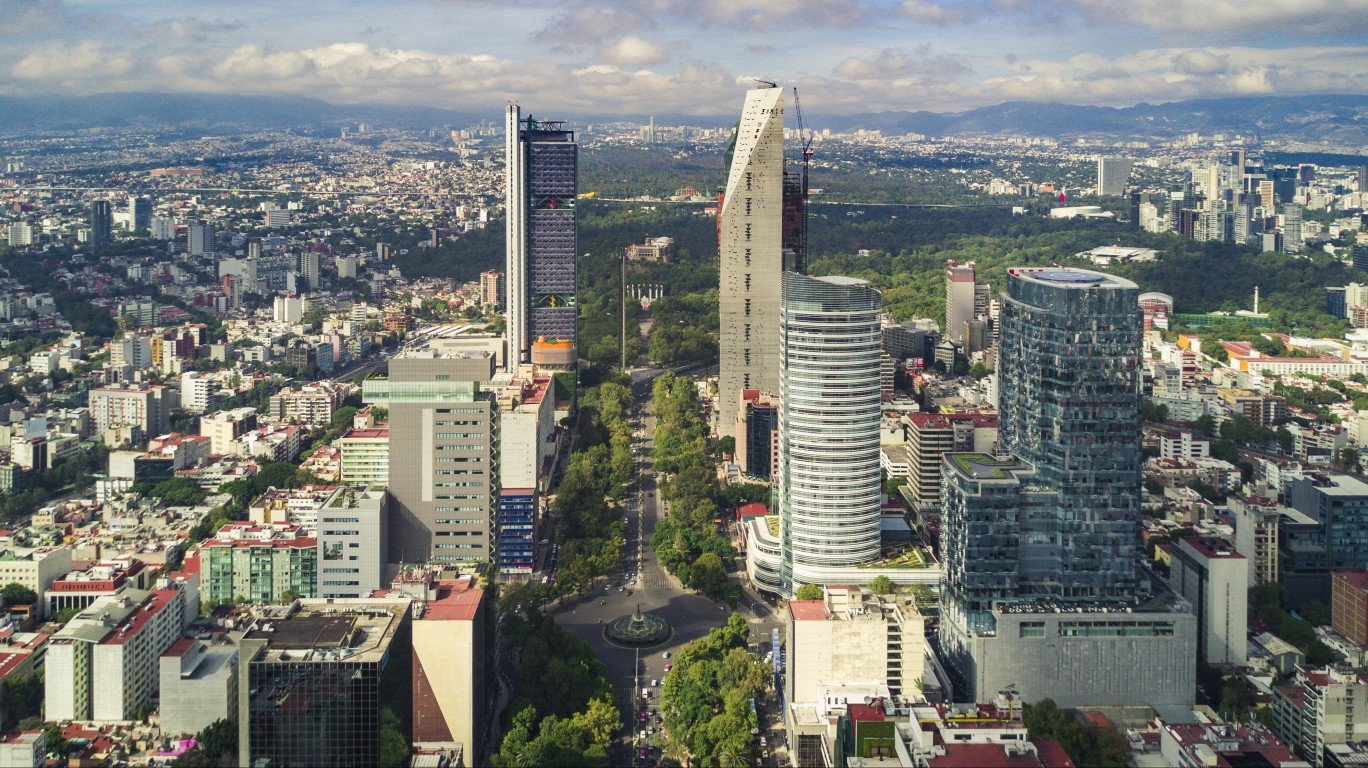
- Estimated population, 2023: 21,905,000
- Built up urban area, 2023: 977 square miles (or 2,530 square km) — #39 largest of 986 urban areas
- Population density: 22,421 people per square mile — #211 densest of 986 urban areas
- Est. GDP, 2023: $250.45 billion — #47 largest metro economy
- World Bank geographical region: Latin America and Caribbean
- Country class (World Bank): Upper middle income
9. Cairo, Egypt
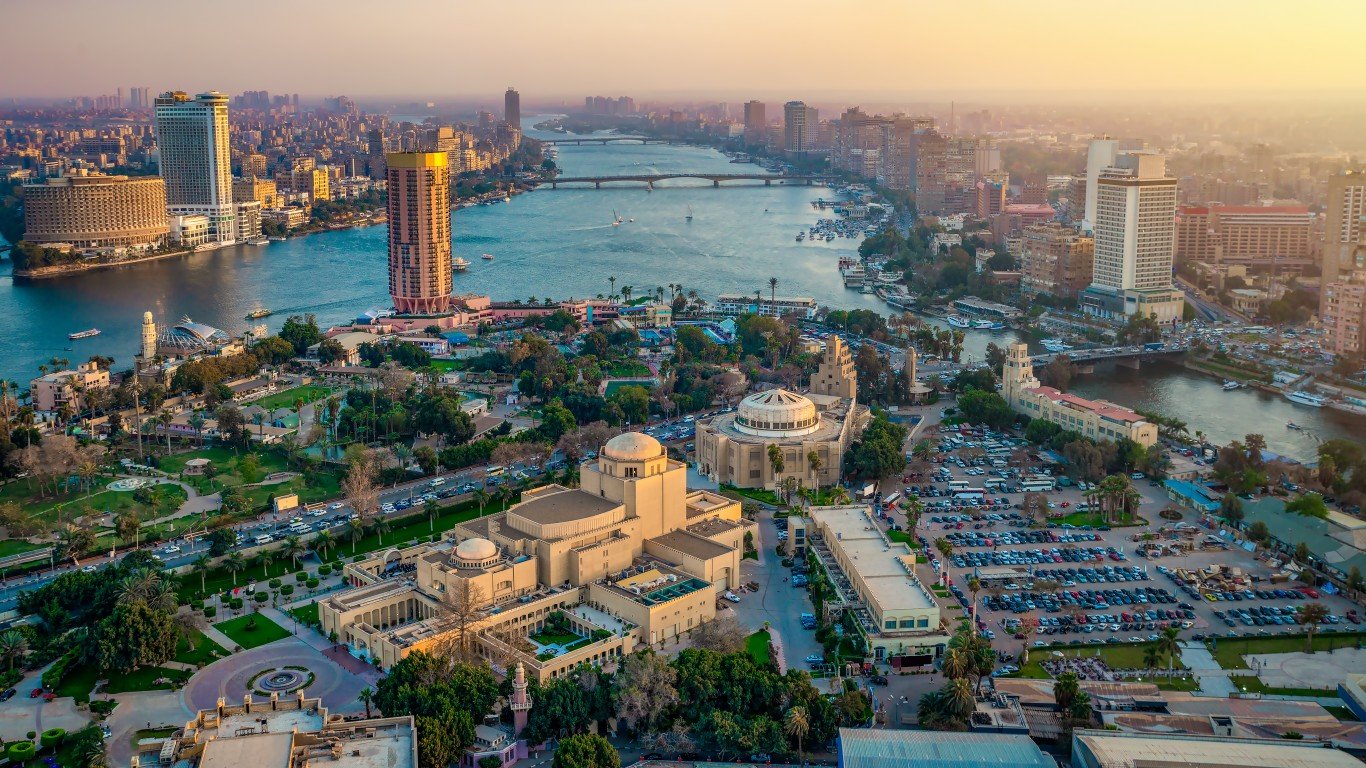
- Estimated population, 2023: 22,679,000
- Built up urban area, 2023: 1,041 square miles (or 2,696 square km) — #35 largest of 986 urban areas
- Population density: 21,786 people per square mile — #221 densest of 986 urban areas
- Est. GDP, 2023: $102.00 billion — #130 largest metro economy
- World Bank geographical region: Middle East and North Africa
- Country class (World Bank): Lower middle income
8. Seoul-Incheon, South Korea
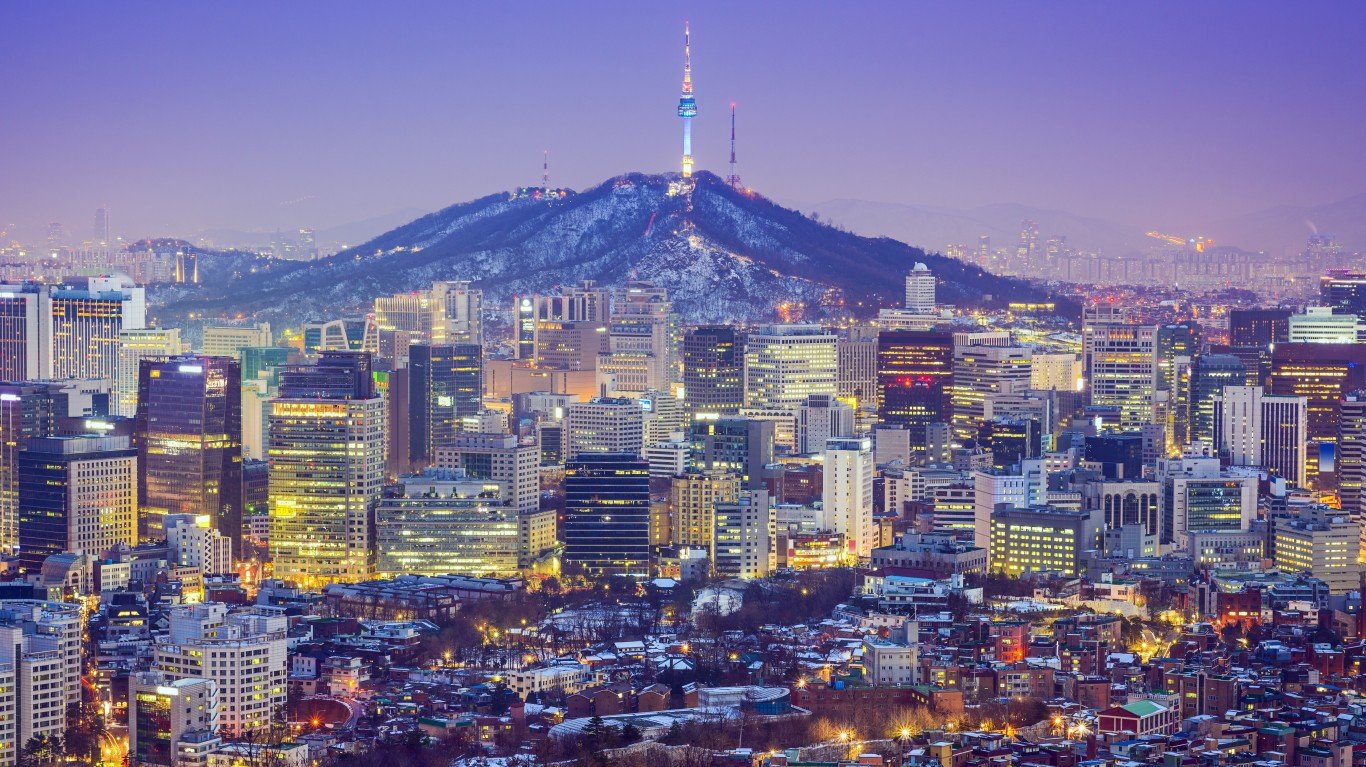
- Estimated population, 2023: 23,225,000
- Built up urban area, 2023: 1,069 square miles (or 2,769 square km) — #34 largest of 986 urban areas
- Population density: 21,726 people per square mile — #223 densest of 986 urban areas
- Est. GDP, 2023: $926.79 billion — #5 largest metro economy
- World Bank geographical region: East Asia and Pacific
- Country class (World Bank): High income
7. Shanghai, SHG-JS-ZJ, China
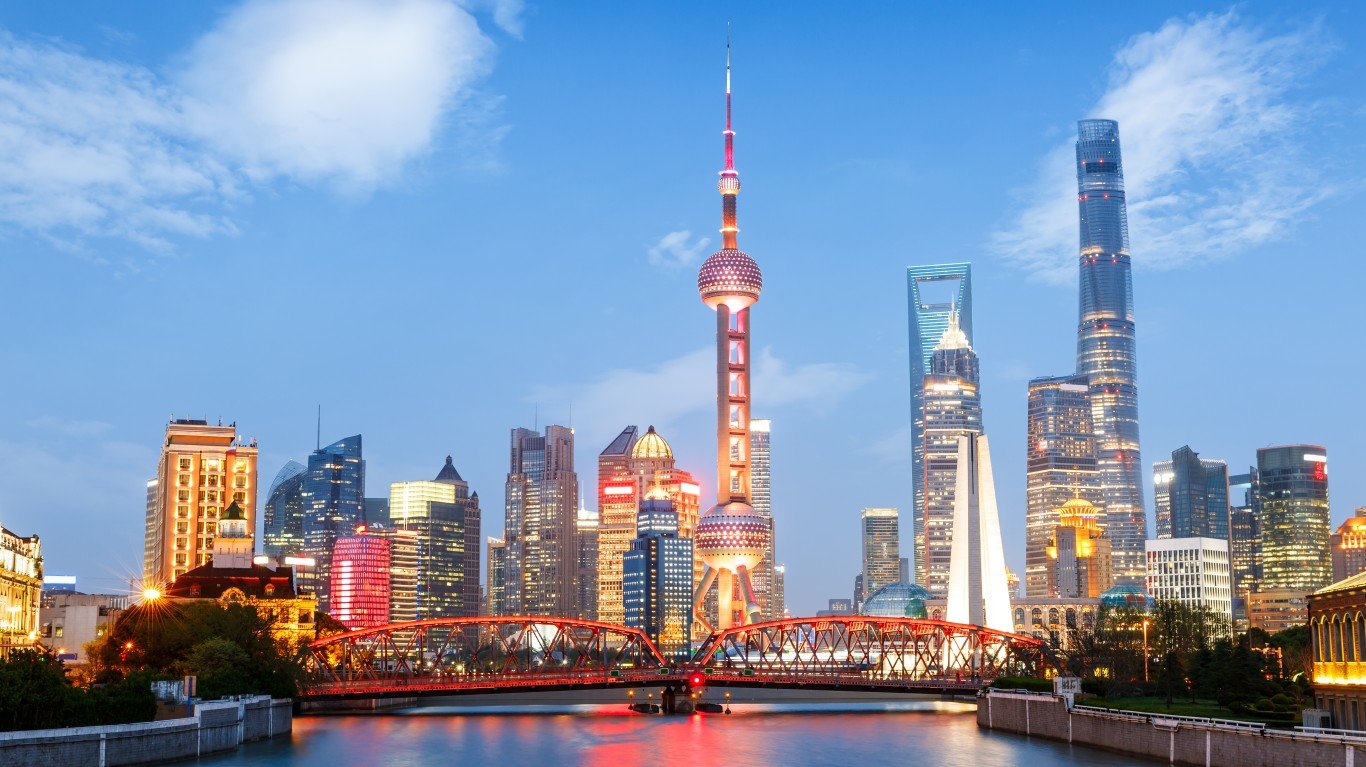
- Estimated population, 2023: 24,042,000
- Built up urban area, 2023: 1,673 square miles (or 4,333 square km) — #13 largest of 986 urban areas
- Population density: 14,371 people per square mile — #401 densest of 986 urban areas
- Est. GDP, 2023: $663.87 billion — #10 largest metro economy
- World Bank geographical region: East Asia and Pacific
- Country class (World Bank): Upper middle income
6. Manila, Philippines
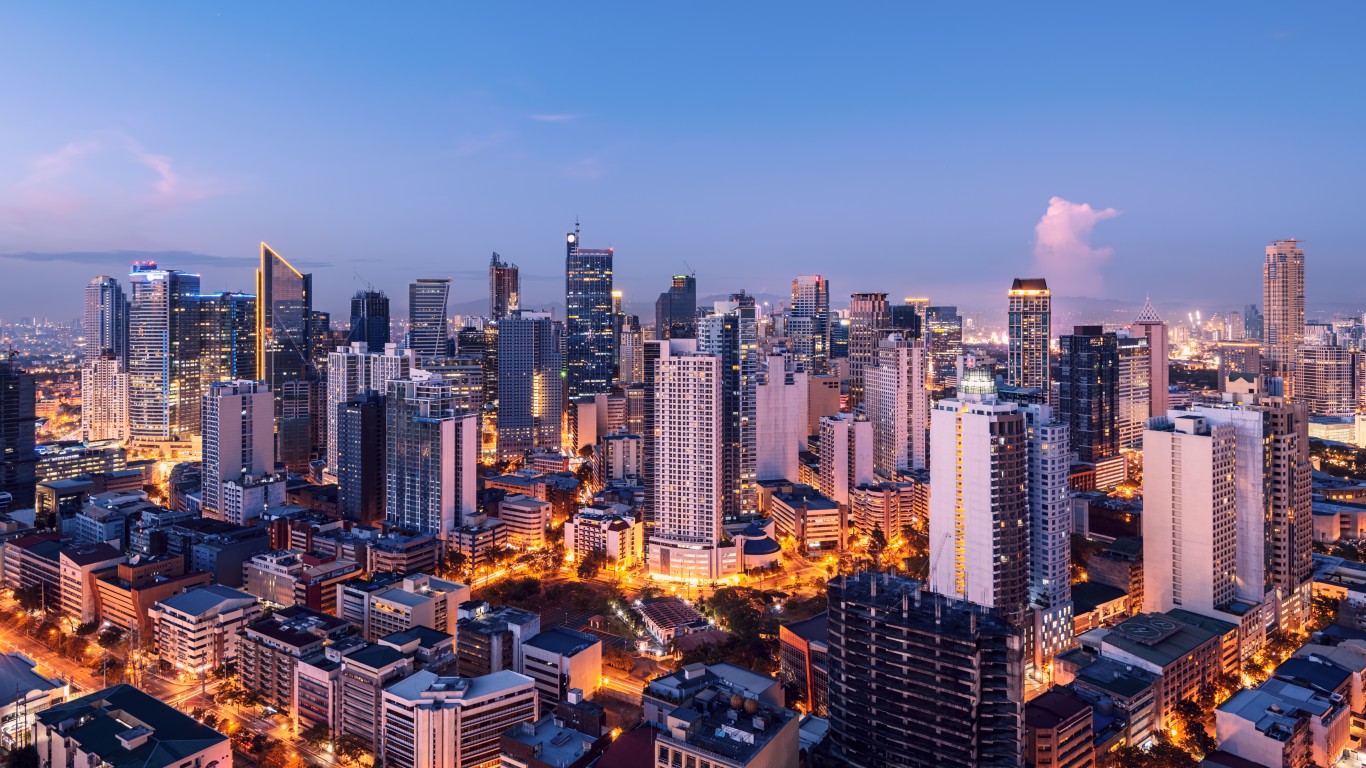
- Estimated population, 2023: 24,156,000
- Built up urban area, 2023: 738 square miles (or 1,911 square km) — #56 largest of 986 urban areas
- Population density: 32,732 people per square mile — #97 densest of 986 urban areas
- Est. GDP, 2023: $192.60 billion — #66 largest metro economy
- World Bank geographical region: East Asia and Pacific
- Country class (World Bank): Lower middle income
5. Mumbai, MH, India
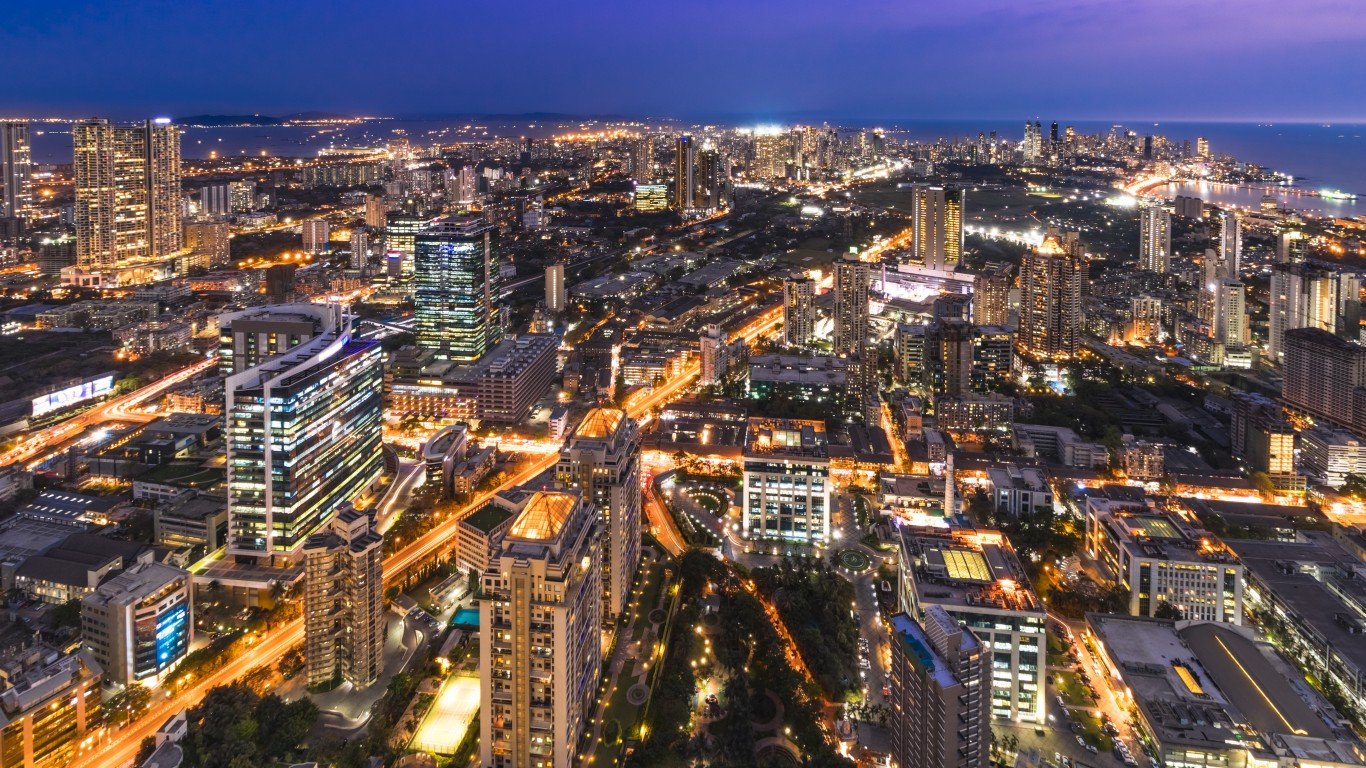
- Estimated population, 2023: 25,189,000
- Built up urban area, 2023: 404 square miles (or 1,046 square km) — #120 largest of 986 urban areas
- Population density: 62,349 people per square mile — #11 densest of 986 urban areas
- Est. GDP, 2023: $277.98 billion — #37 largest metro economy
- World Bank geographical region: South Asia
- Country class (World Bank): Lower middle income
4. Guangzhou-Foshan, GD, China
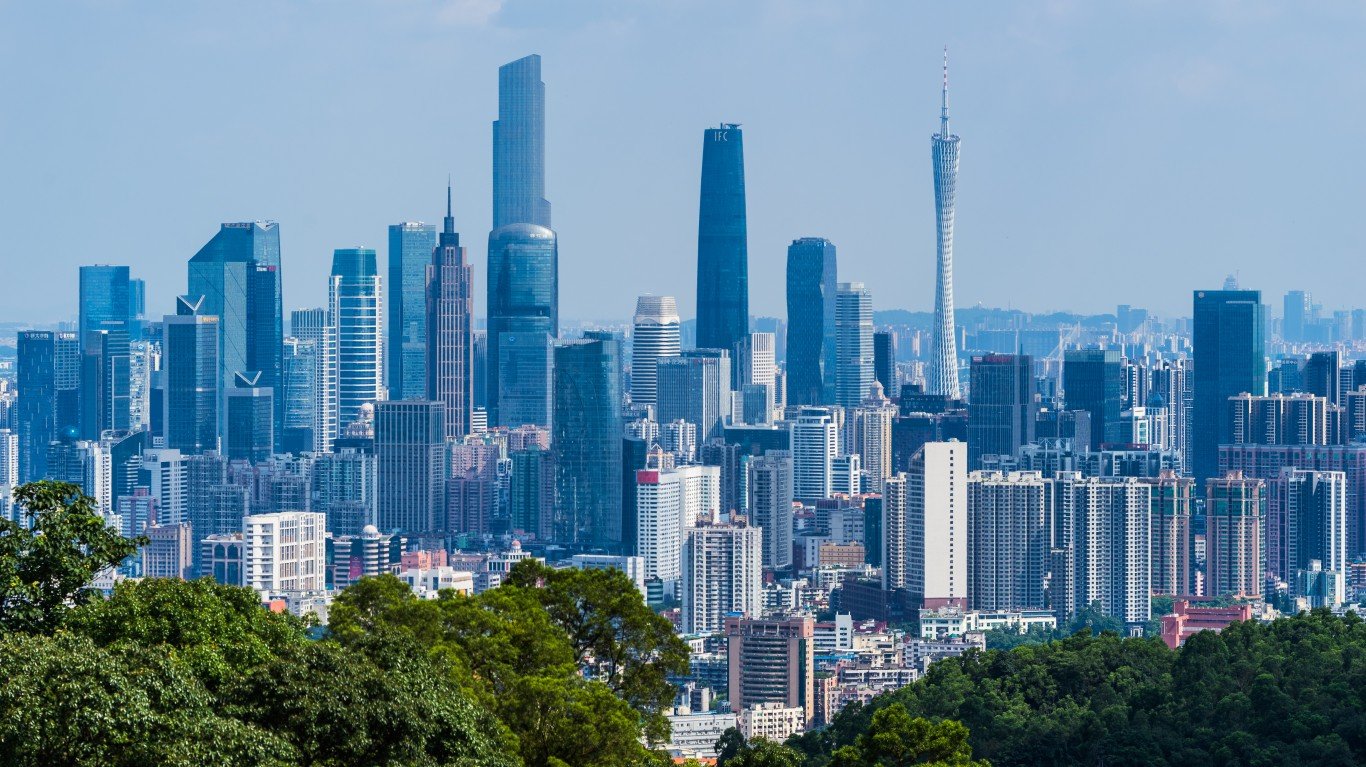
- Estimated population, 2023: 27,119,000
- Built up urban area, 2023: 1,754 square miles (or 4,543 square km) — #12 largest of 986 urban areas
- Population density: 15,461 people per square mile — #360 densest of 986 urban areas
- Est. GDP, 2023: $405.35 billion — #27 largest metro economy
- World Bank geographical region: East Asia and Pacific
- Country class (World Bank): Upper middle income
3. Delhi, DL-UP-HR, India
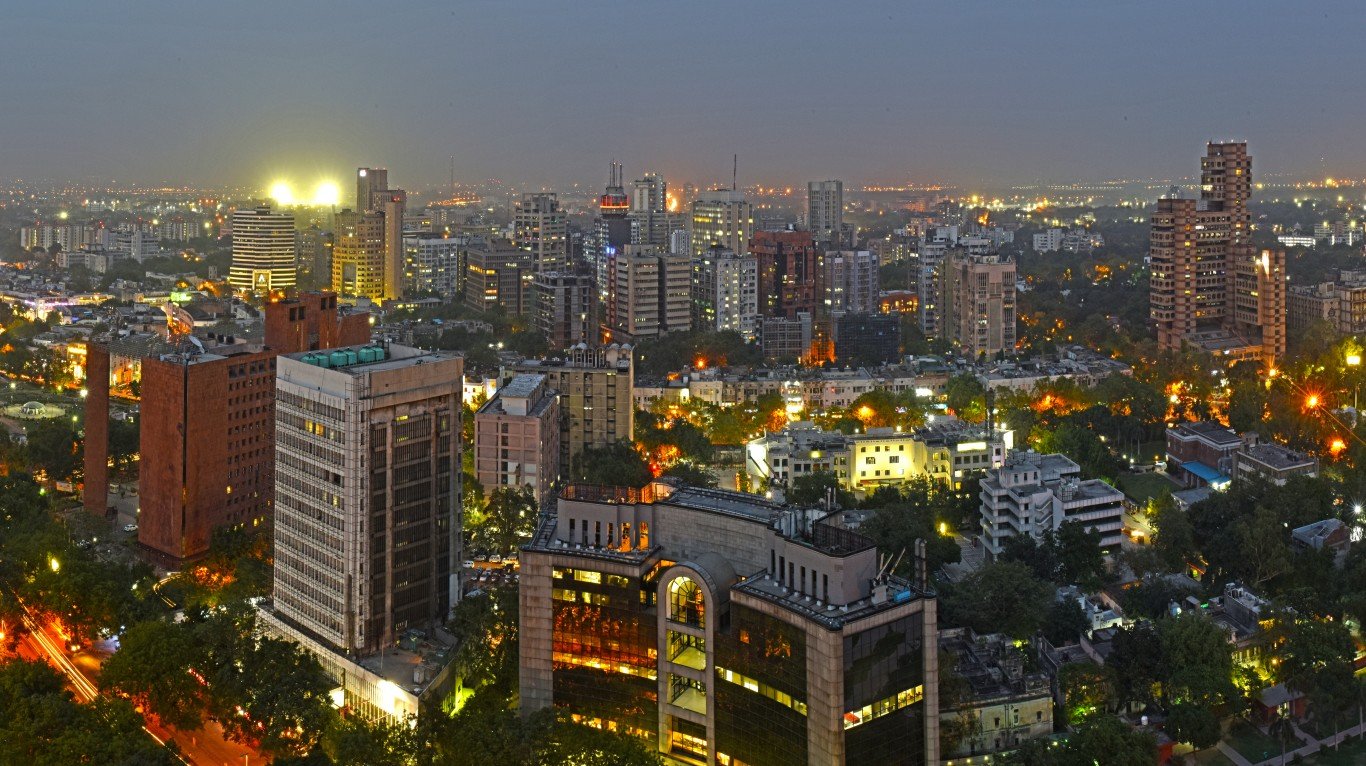
- Estimated population, 2023: 31,190,000
- Built up urban area, 2023: 905 square miles (or 2,344 square km) — #43 largest of 986 urban areas
- Population density: 34,464 people per square mile — #88 densest of 986 urban areas
- Est. GDP, 2023: N/A
- World Bank geographical region: South Asia
- Country class (World Bank): Lower middle income
2. Jakarta, Indonesia
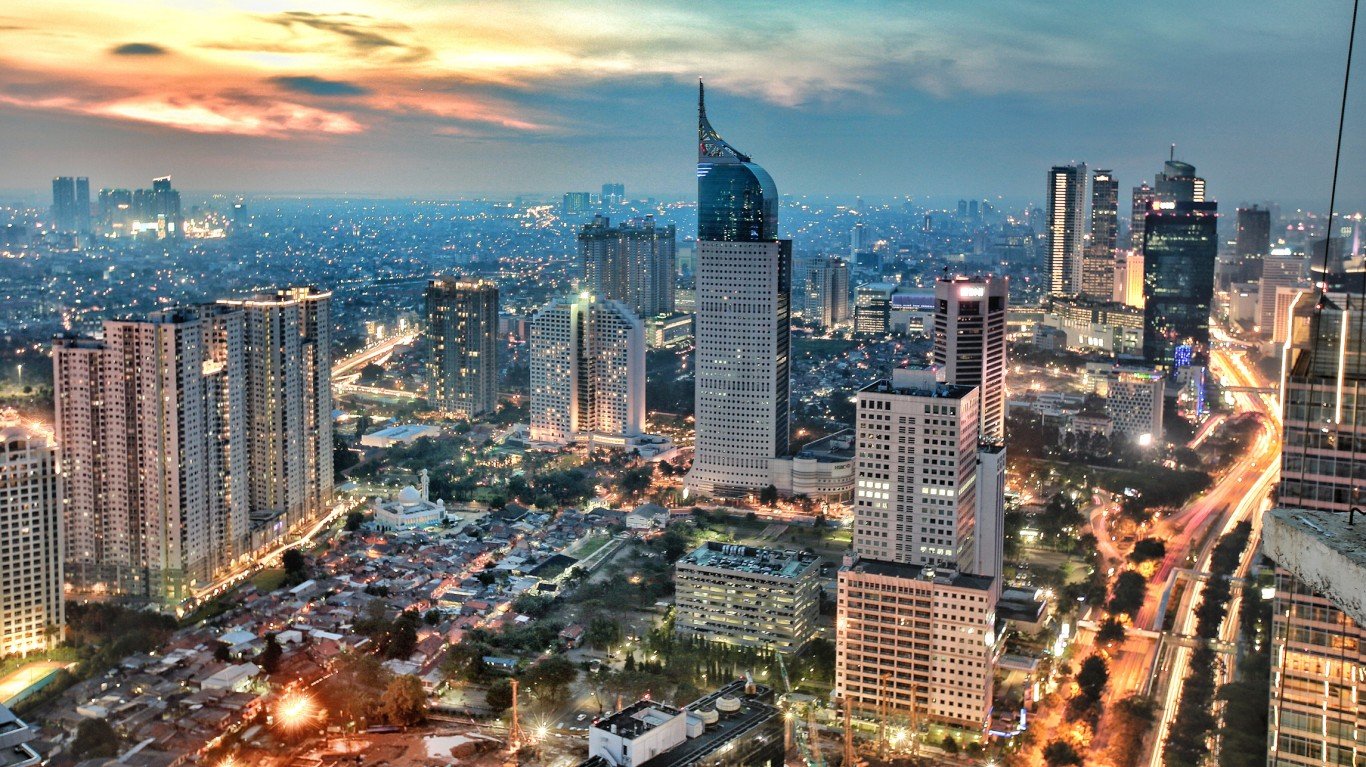
- Estimated population, 2023: 35,386,000
- Built up urban area, 2023: 1,369 square miles (or 3,546 square km) — #22 largest of 986 urban areas
- Population density: 25,848 people per square mile — #162 densest of 986 urban areas
- Est. GDP, 2023: $308.25 billion — #33 largest metro economy
- World Bank geographical region: East Asia and Pacific
- Country class (World Bank): Upper middle income
1. Tokyo-Yokohama, Japan
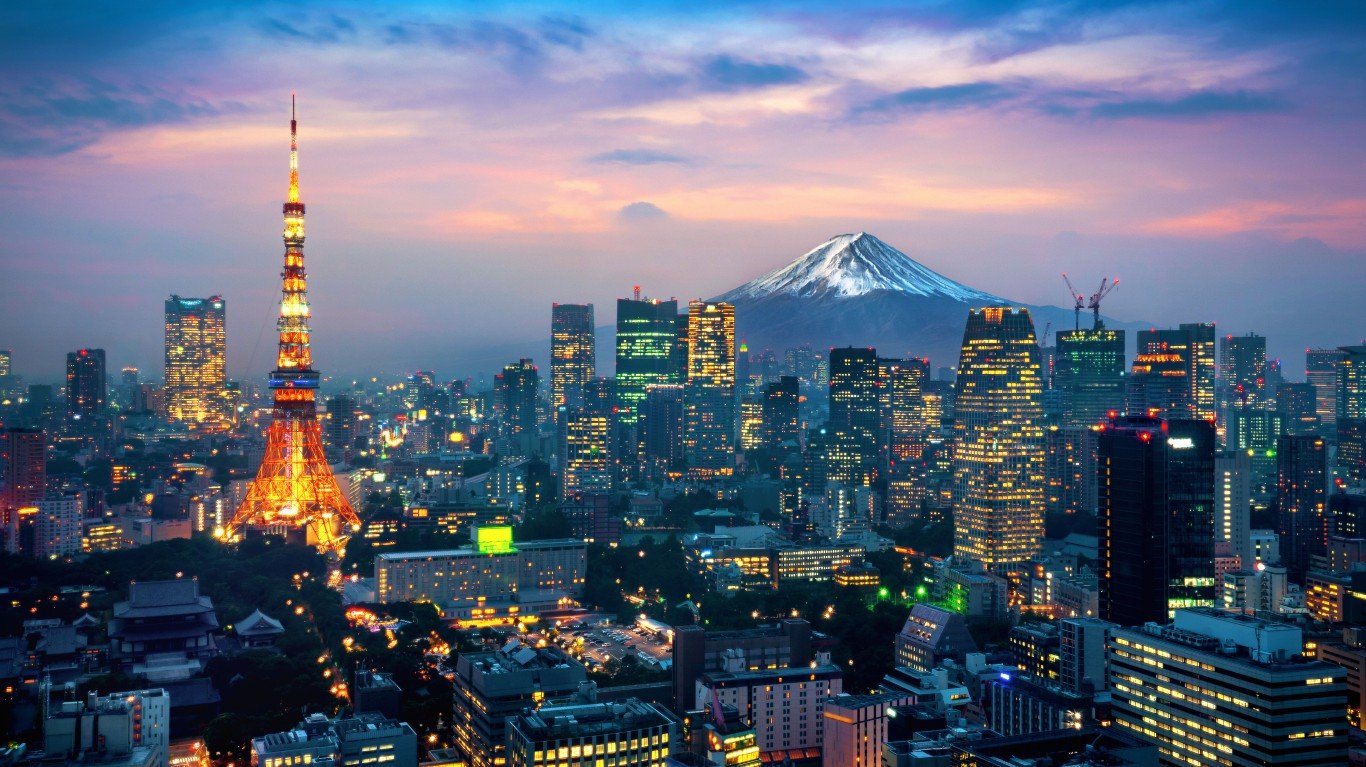
- Estimated population, 2023: 37,785,000
- Built up urban area, 2023: 3,388 square miles (or 8,775 square km) — #3 largest of 986 urban areas
- Population density: 11,153 people per square mile — #547 densest of 986 urban areas
- Est. GDP, 2023: $2,055.69 billion — #1 largest metro economy
- World Bank geographical region: East Asia and Pacific
- Country class (World Bank): High income
Essential Tips for Investing: Sponsored
A financial advisor can help you understand the advantages and disadvantages of investment properties. Finding a qualified financial advisor doesn’t have to be hard. SmartAsset’s free tool matches you with up to three financial advisors who serve your area, and you can interview your advisor matches at no cost to decide which one is right for you. If you’re ready to find an advisor who can help you achieve your financial goals, get started now.
Investing in real estate can diversify your portfolio. But expanding your horizons may add additional costs. If you’re an investor looking to minimize expenses, consider checking out online brokerages. They often offer low investment fees, helping you maximize your profit.
Thank you for reading! Have some feedback for us?
Contact the 24/7 Wall St. editorial team.
